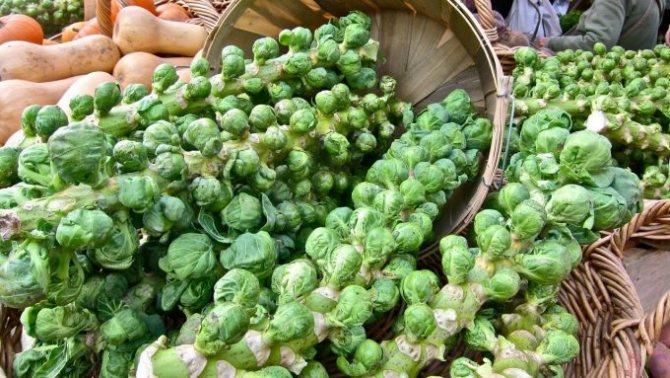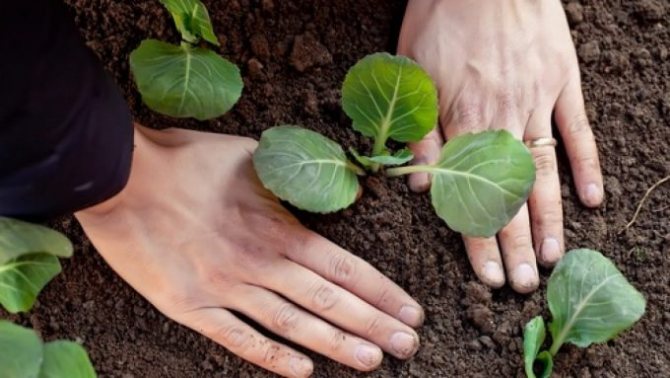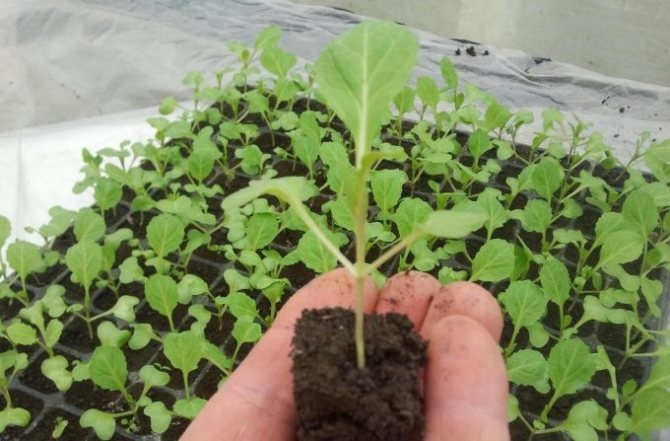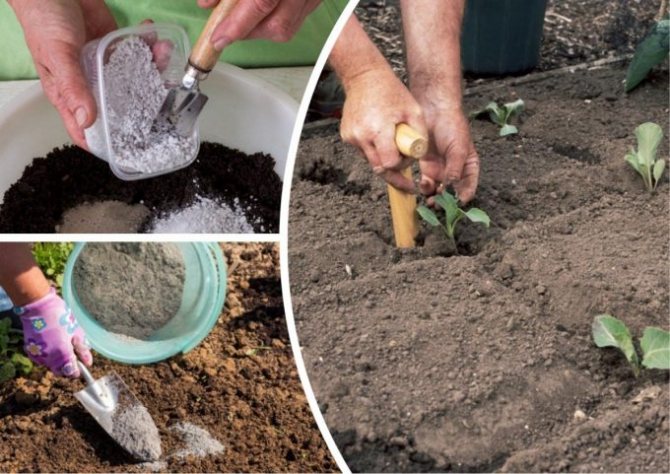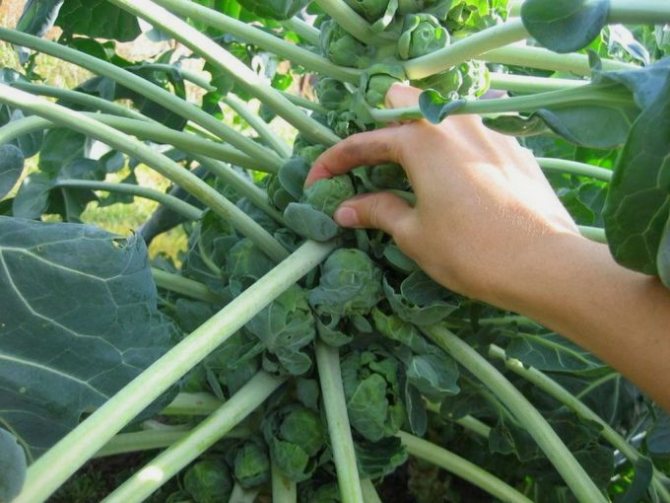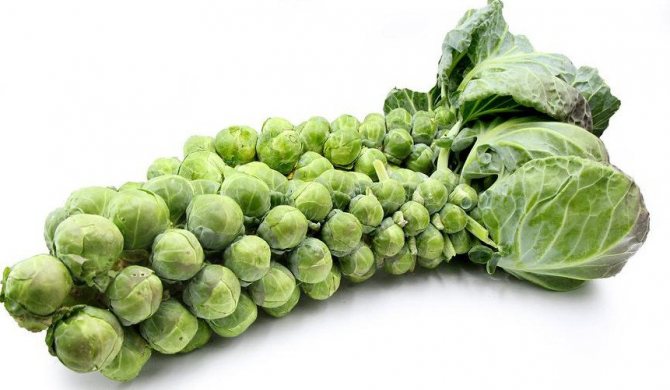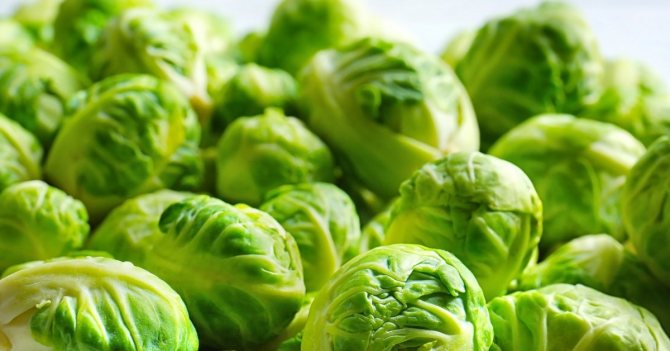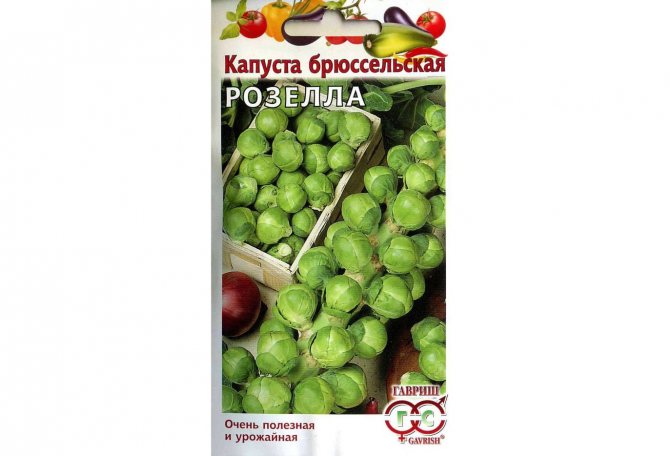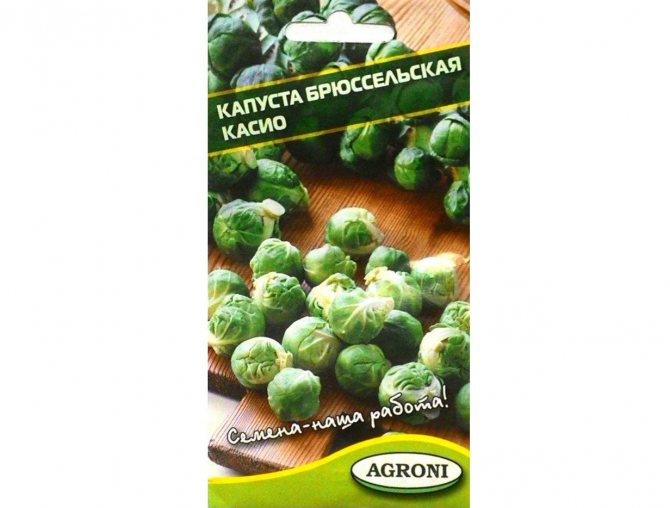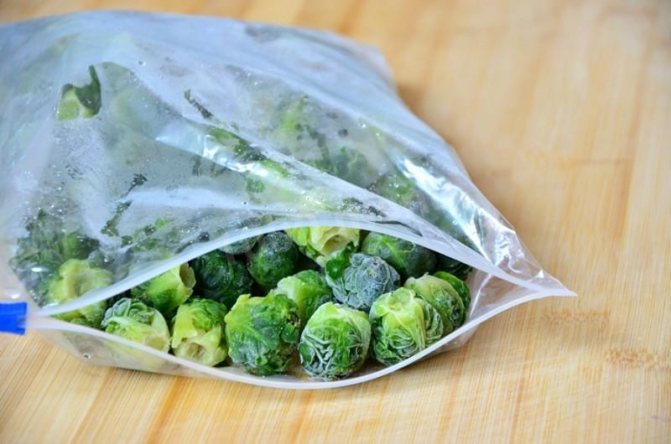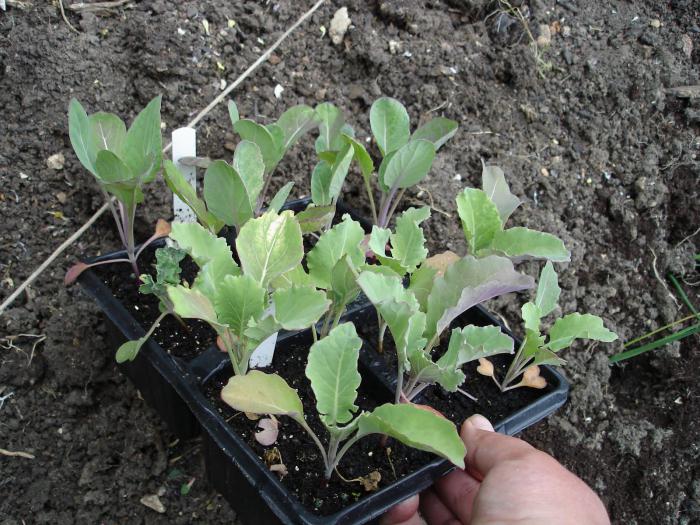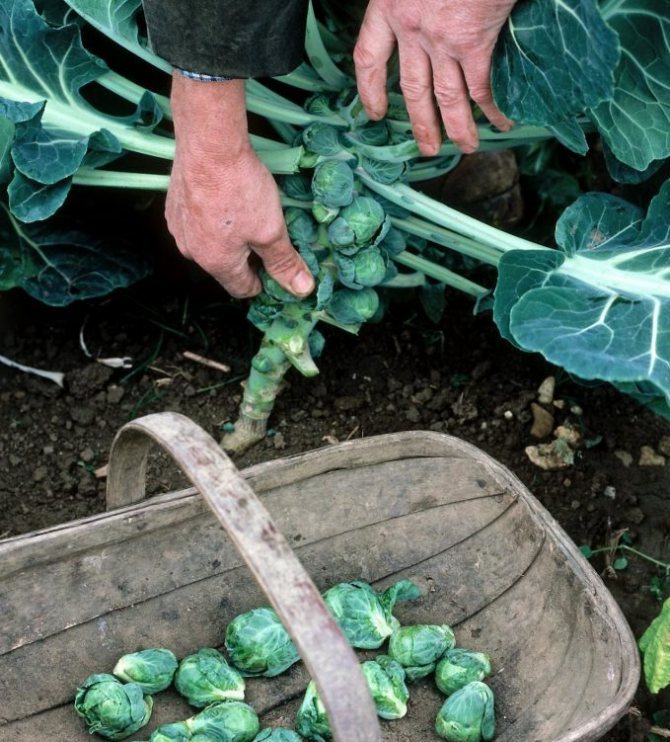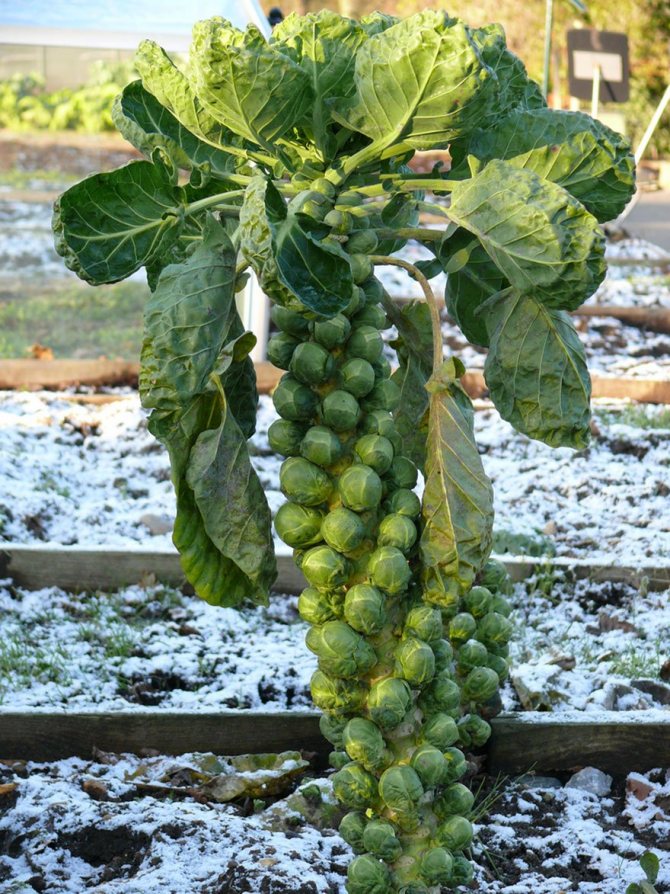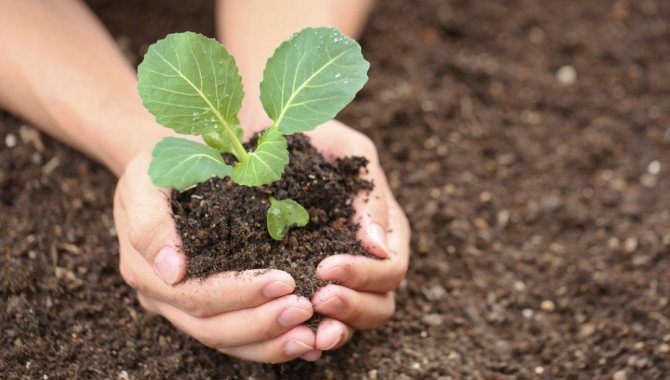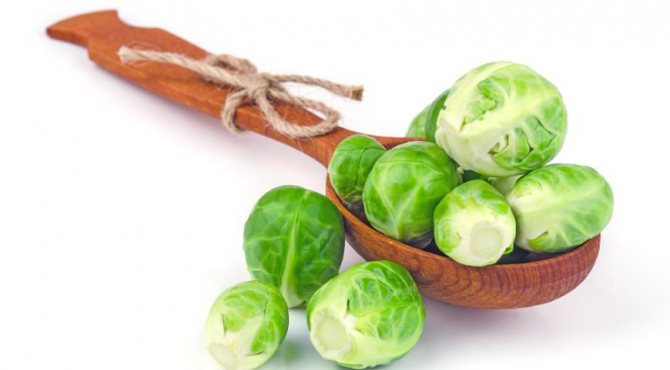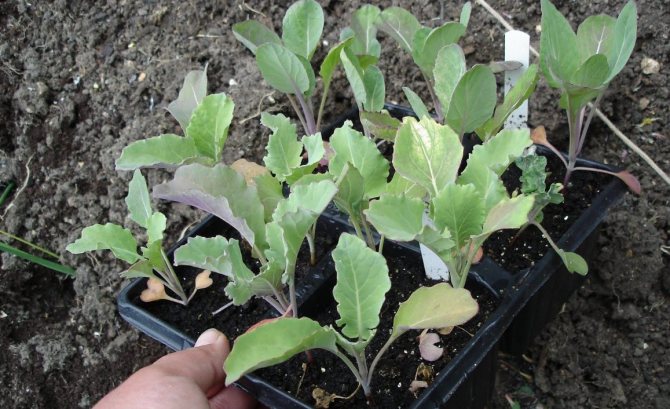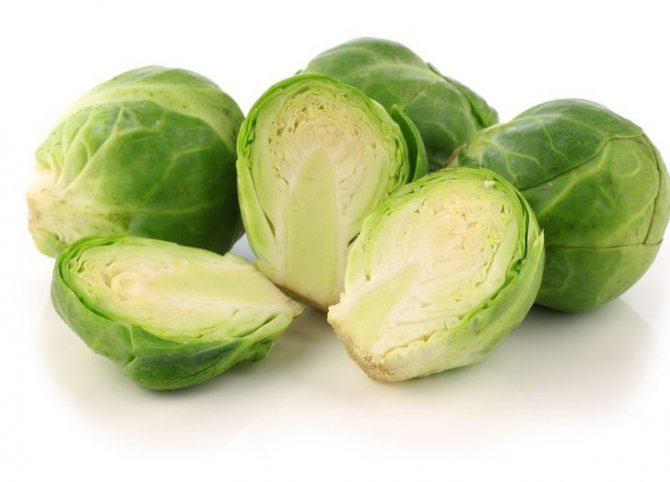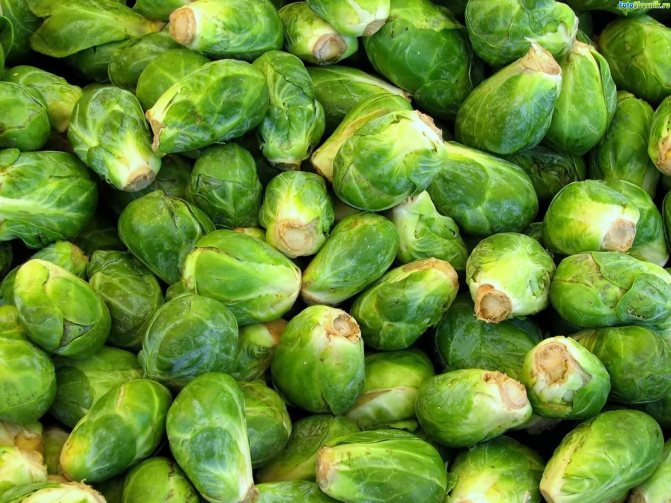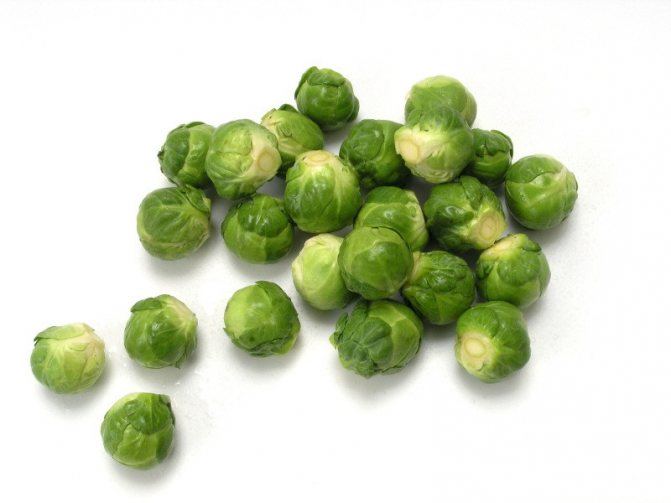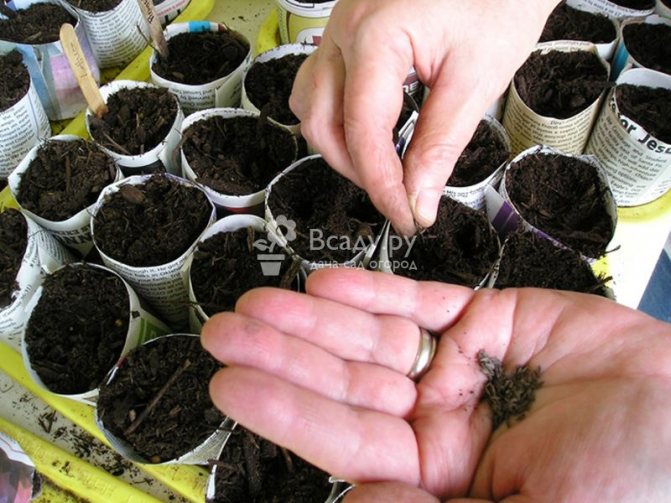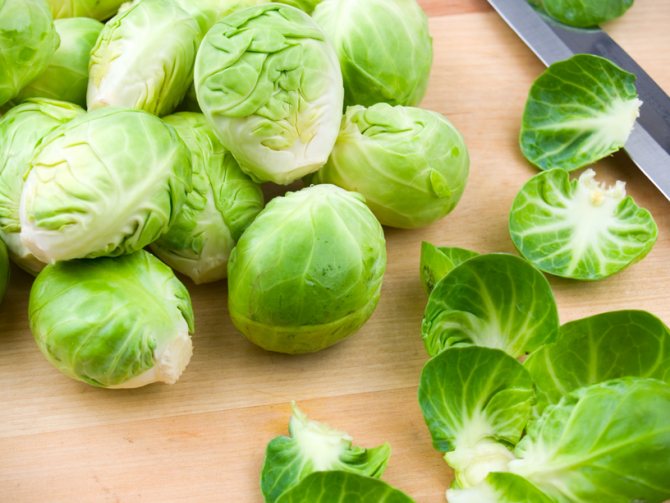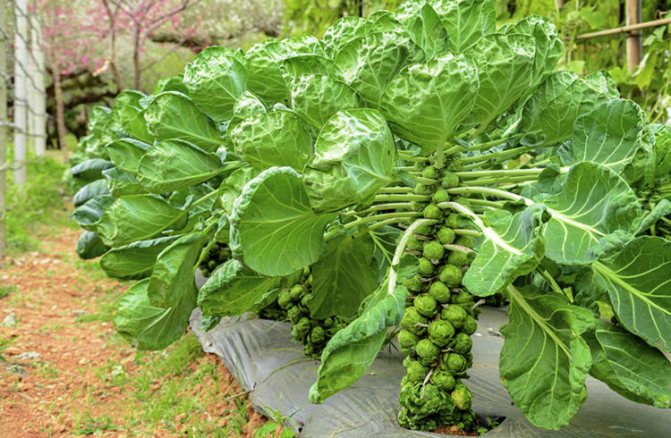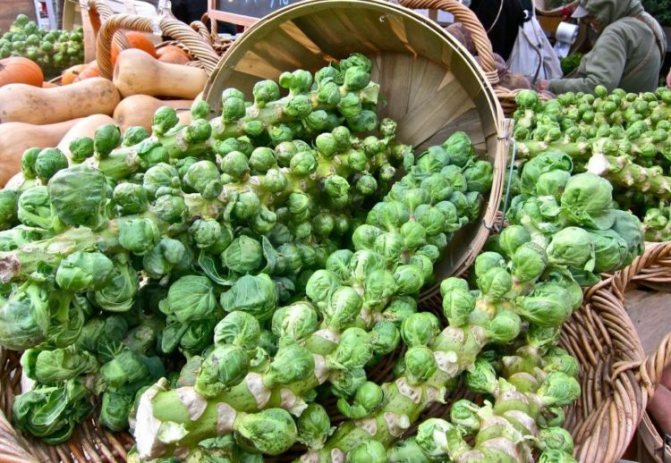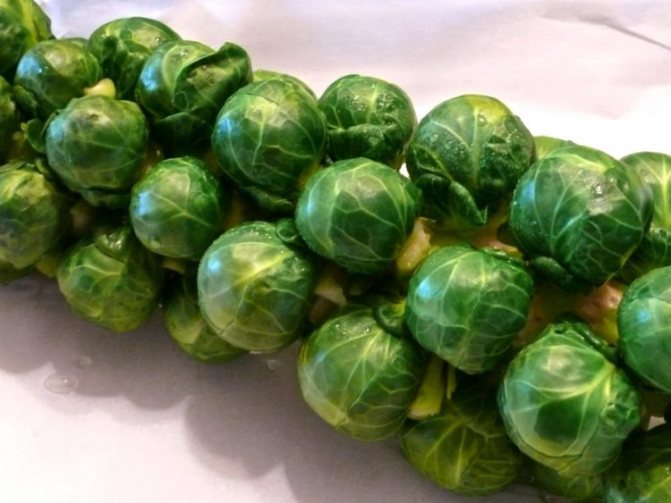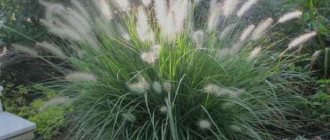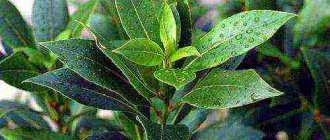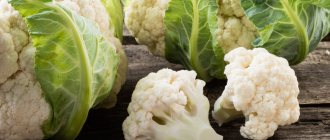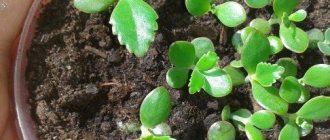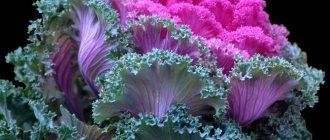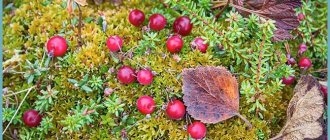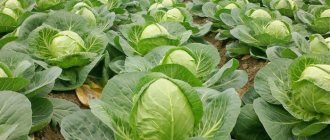Brussels sprouts and their taste are known all over the world. This gourmet vegetable is good for health, as it contains a large amount of vitamins PP, C, A, salts of iron, magnesium, potassium and other nutrients useful for the body. Thanks to this, in many countries of Western Europe, the USA and Canada, it is grown on an industrial scale. In our country, she began to gain popularity quite recently. To get the full taste and benefits of this vegetable, it is important to know how to properly grow Brussels sprouts from sowing to harvest.
History of the spread of culture
Brussels sprouts are the fruit of the selection of Belgian vegetable growers; they do not grow in the wild. The culture, bred by breeders, has its origin from wild collard greens - it once grew in abundance in the Mediterranean region, and was cultivated in antiquity.
It is believed that Brussels sprouts were developed in the 13th century. The famous scientist and naturalist Karl Linnaeus was the first to describe the new culture, calling it "Brussels". On a large scale, unusual cabbage began to be grown in the 18th century, in Russia it appeared in the middle of the 19th century, but did not receive wide distribution here. The Russian climate is not particularly like this culture, therefore it is grown in the Russian Federation on a limited basis.
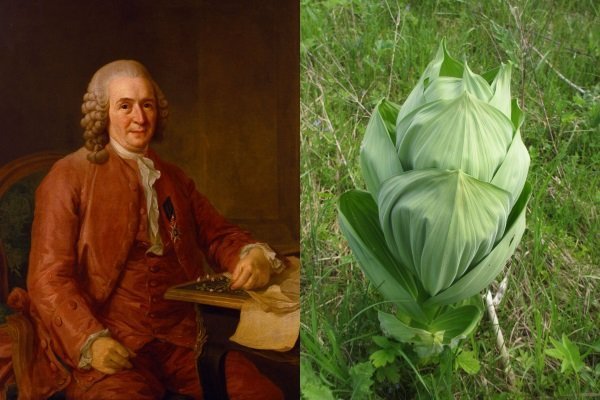
Origin and description of culture
Thanks to the efforts of Belgian vegetable growers, an unusual vegetable appeared, called Brussels sprouts. Later she "migrated" to Germany, Holland and France. In the middle of the 19th century, it appeared in Russia, but did not receive much popularity. Outwardly, it is very different from the usual leaf relative.


Consider what this plant looks like:
- stem height up to 50-60 cm;
- the stem is covered with leaves of medium size, located on thin petioles;
- small (up to 10–20 g) heads are formed at the base of the leaves;
- up to 40 or more fruits grow on one specimen.
Brussels sprouts are a biennial plant. In the first year, heads are formed on it, and in the second year, flowering shoots are formed on it. After pollination, pods with a large number of small seeds are formed from yellow flowers collected in a brush (there are up to 200-300 seeds in 1 g).
Did you know? Jersey, which is located in the English Channel, grows "Jersey" cabbage. It is up to 4 m high and has edible leaves. But locals mainly use its stems, from which furniture parts are made.
Botanical description
Brussels sprouts (Brássica oleracea) are vegetable and collard greens belonging to the cruciferous family. This biennial cross-pollinated plant is strikingly different from all other representatives of the cabbage family.
What Brussels sprouts look like:
- In the 1st year. On a thick stem, there are small and medium leaves with thin petioles. The height of the stem is 20-60 cm. The length of the weakly lyre-shaped leaves is 15-35 cm. The leaves are green or gray-green, on the surface there is a weak waxy bloom. In the axils of the leaves, on the tops of short stems, small heads of cabbage grow - the size of a walnut. One plant produces 20-40 miniature heads of cabbage, each weighing about 10 g.
- In the 2nd year. Branched flowering shoots develop.The plant blooms and then produces seed-filled fruits. The flowers are yellow, collected in inflorescences. The fruit is a polyspermous pod.
Popular varieties
Early: Brilliant F1, Oliver, Dopmik F1
Medium early: Rosella, Long Island
Mid-season: Casio
Late: Falstaff, Curl
Read about other varieties of Brussels sprouts, their features and characteristics, in the article "The best varieties of Brussels sprouts."
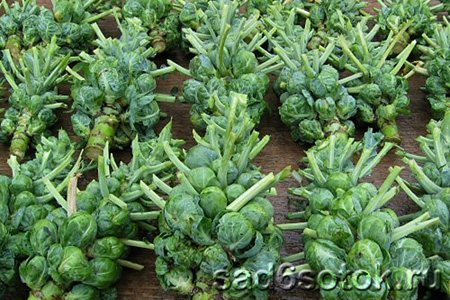

Hercules is a late variety. Brought to VNIISSOK. The height of the stem is 45-60 cm. There are 20-30 heads of cabbage on the plant: not very dense and loose, 3-5 cm in diameter, they consist of corrugated leaves.
Seed growing
The agricultural technology of Brussels seed production is the same as that of white cabbage, and includes three stages:
- Growing mother plants. Seeds are sown at the same time as when growing to obtain a crop. The mothers are harvested before frost. Take well-developed and well-formed plants. The heads of cabbage should be firm and large enough.
- Winter storage. Before laying for storage, the leaves are cut off, leaving the apical bud a couple of centimeters above the heads of cabbage. The mothers are placed in rows in piles or in cold storage facilities, and sprinkled with sand. Storage temperature - from 0 to + 1 ° C, humidity - 90-95%. The petioles are cut off as they dry.
- Planting seeds. In the spring, mother liquors are grown - 2-3 weeks before planting, they are dropped in the open field. Then they are planted at intervals of 70 cm, the distance between the rows is also 70 cm. Planting is carried out as soon as the soil is ready. The seed plants are looked after - I weed the weeds, feed them, destroy pests, water them, huddle up and tie them up. When the seeds reach milky-wax ripeness, the shoots are cut and folded under a canopy. Or they are collected in small sheaves so that the fruits ripen.
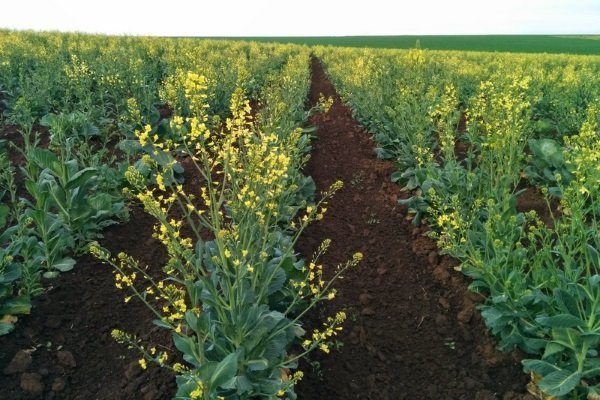

Harvesting and storage
The heads of cabbage begin to ripen about the third month after the Brussels sprouts are planted in the open ground. However, experienced gardeners advise harvesting only after the onset of cold weather... The plant tolerates cooling well, while the taste of cabbage improves from subzero temperatures.
Home care for aloe, transplant and reproduction
First of all they collect lower heads of cabbage... The upper ones are left so that they acquire the desired density and volume.
When the foliage that covers the heads of cabbage begins to fall, you can start mass harvesting. To do this, the stem is cut at the root wall, and the leaves and apical bud are cut off. The heads are left on the stem where they can be stored for up to three months.
For long-term storage, the plant is dug up together with the root, the leaves are cut off from it, placed close to each other in the cellar and added dropwise. About thirty copies can be placed on one square meter.
Brussels sprouts can be frozen or store for about a month and a half in the refrigerator, previously wrapped in polyethylene... If there is a cellar, but the plants cannot be dug in there, then they can simply be put in boxes.
Benefit and harm
Brussels sprouts contain a large amount of vitamins, minerals, and many other beneficial substances that have a beneficial effect on the body.
Benefits of Brussels Sprouts:
- It contains a lot of carotenoids - these elements have a beneficial effect on the retina.
- Regular consumption reduces the risk of developing asthma, increases immunity to viral infections.
- Thanks to the fiber contained in the vegetable, toxins and toxins are removed, the acidity of the stomach decreases, constipation and heartburn are prevented.
- Reduces the concentration of cholesterol in the blood, has a choleretic effect, restores the liver.
- Strengthens the walls of blood vessels and normalizes cardiac activity.
- Contains a lot of calcium, which is essential for healthy hair, bones and nails.
- Inhibits the development of breast cancer.
- Contains folic acid that women need during pregnancy.
- Restores the functions of the pancreas, recommended for diabetes.
Brussels sprouts are contraindicated for people:
- with individual intolerance to the product - strong allergic reactions may appear;
- with a tendency to heartburn and flatulence - cabbage can provoke an exacerbation.
Useful properties and contraindications
Rich in vitamins, enzymes, amino acids and various minerals, the vegetable is very beneficial for the body. Its use contributes to:
- improving vision;
- lowering cholesterol levels;
- the fight against excess weight;
- reducing the risk of birth defects;
- good bowel function;
- enhancing mental activity;
- prevention of tumor development;
- reducing the risk of respiratory disease;
- good work of the pancreas;
- normalization of blood pressure in hypertensive patients;
- healing of wounds after surgery;
- increased immunity;
- normalization of the cardiovascular system.
The dietary product is recommended for the elderly and children. However, Brussels sprouts are not good for everyone. It is contraindicated in the following pathologies:
- gout;
- Crohn's disease;
- weakened pancreatic function;
- increased acidity of gastric juice.
In the latter case, you can eat the vegetable, but infrequently and with caution.
In cooking, Brussels sprouts are used for preparing a side dish to fish or meat, soups, salads and to decorate various dishes. Even a novice gardener can take up the cultivation of Brussels sprouts, since this culture is unpretentious in care. However, you should first study the rules for growing it from seeds and features of care. As a result, it will be possible to harvest a good harvest of healthy vegetables in the fall.
Requirements for climatic conditions and soil
Cabbage, bred in Belgium, prefers moderation in the weather - it does not like heat and dampness, it needs a favorable, moderate weather in all respects. The best option for growing "Brussels" is climatic zones characterized by long, warm autumn.
In countries with a favorable climate for Brussels sprouts, for example, in Holland, it is grown even in winter. But the largest yields are in the USA, Canada and the UK.
To grow safely, having accumulated a full set of vitamins in the right amount, Brussels sprouts need the following conditions:
- optimal growing temperature - from +18 to + 22 ° C;
- temperature of + 25 ° C and above is not permissible - the growth of the crop stops, the yield drops;
- during the period of intensive growth - the predominance of sunny days over cloudy ones, and the latter should be a minimum;
- the absence of nitrogen fertilizers leading to the accumulation of nitrates in the vegetable;
- the culture is extremely cold-resistant - seeds begin to grow already at + 2 ° C, adult plants are able to withstand frosts down to -10 ° C.
The culture is cold-resistant. It tolerates frosts, which are detrimental to most plants, without any significant consequences for growth and productivity. Adult cabbage tolerates frosts especially well - frosts down to minus 5-7 ° C. After the frost has receded, the cabbage thaws and starts growing again. Moreover, it is believed that frosts are good for the "Brussels" - the taste of its "micro-heads" becomes even better.
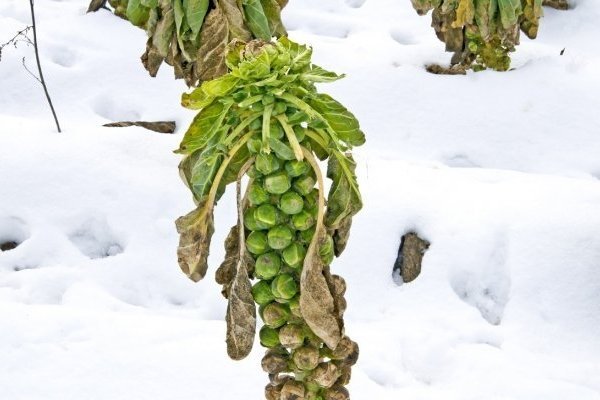

Brussels sprouts, in comparison with white cabbage, are not so demanding on soils:
- can grow on light soils that are not highly fertile;
- prefers soils with a high calcium content;
- recommended acidity pH - 6.0-7.0.
Tips and secrets of growing cabbage
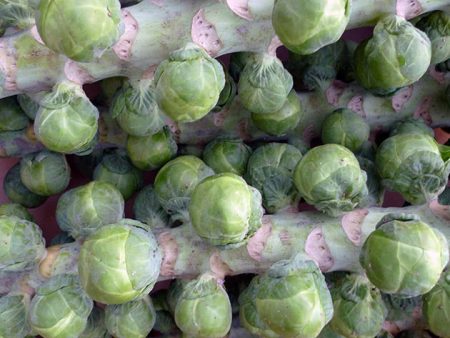

The successful cultivation of vegetables depends on the climate and weather conditions of the region, adherence to agrotechnical rules and many other factors:
- the selected variety must correspond to the climatic conditions of the area in which it is grown;
- before buying, you should familiarize yourself with the characteristics of the hybrid;
- it is better to purchase seed from trusted manufacturers;
- with an excess of nitrogen, cabbage fattens, foliage grows, heads are not formed;
- if the lower leaves are removed, the heads of cabbage ripen faster under the sun;
- with increased acidity of the soil, ash and limestone are introduced;
- the plant does not tolerate drought, with a lack of water, the heads are small and have a bitter taste;
- no need to worry if there are no ovaries for a long time, heads of cabbage begin to form in mid-August;
- really turn your favorite business into a business, with a competent approach you can get a good income from a small area.
Brussels sprouts will decorate any festive table. Heads of cabbage are fried, pickled, stewed, stuffed. Fresh vegetables in a salad seasoned with sauce are delicious. And for vitamins and nutrients, she breaks records among her sisters. It is worth trying to grow Brussels sprouts to be sure of its qualities.
Preparing for landing
In order for the proper amount of tasty and nutritious heads of cabbage to ripen on Brussels sprouts, the culture must be planted correctly and on time. Gardeners prepare the soil and seeds in advance - future yield depends on their quality.
Terms and conditions
The timing of planting seeds depends on several factors:
- climatic features of the region;
- current weather - this is especially important when growing seedlings;
- varieties of Brussels sprouts.
For central Russia, the optimal time for sowing seeds is 2-3 weeks of April. The early varieties are sown at the end of March, the later ones after April 10. Seedlings are planted much later - in early June, but no later than the 10th.
Soil preparation
Brussels sprouts grow on any soil, even slightly acidic ones. But to get a good harvest, you need dense and at the same time breathable, organic-rich soils. If the soil is poor, infertile, cabbage will grow, but very slowly.
When planting a culture in a new, not fertilized place, the soil is prepared by adding for each square meter:
- humus - 1 bucket;
- nitrophoska - 1/2 cup;
- lime or wood ash - 2 cups.
You can also add urea (14 g), potassium chloride (4 g), superphosphate (30 g), and during planting seedlings - 1/2 teaspoon of nitroammophoska in each hole.
Having scattered the fertilizer over the site, it is dug up, leveled and watered with potassium permanganate - to disinfect the earth. 1.5 g of potassium permanganate is added to 10 liters of water. Watering rate - 3 liters per 1 sq. m. Instead of potassium permanganate, you can use "Fitosporin" - it is used 1-2 weeks before planting.


Brussels sprouts consume a lot of nitrogen and potassium during the growing season. The culture is responsive to organic fertilizers. It is not recommended to use fresh manure as fertilizer - it delays the formation and worsens the commercial qualities of the heads of cabbage, they become loose and poorly stored.
When planting cabbage with seedlings in an area where legumes, tomatoes or cucumbers have grown before, then you can do without fertilizing - if organic matter has already been introduced before planting.
Seed preparation
If you buy a little seed - for testing, then you can take those that have already passed industrial processing. If you have to plant a large amount of cabbage, then it is more profitable to buy untreated seeds - they are cheaper. But only they will have to be processed in a stimulator and disinfector on their own.
Seed processing procedure:
- immersion in water with a temperature of 50 ° C - for 20 minutes;
- taking the seeds out of hot water, rinsing them in running water - 1-2 minutes;
- stand for 12 hours in "Kornevin" or "Epin";
- washed and put in the refrigerator for 24 hours - in the lower drawer for vegetables;
- dry the seeds so that they do not stick to hands during sowing.
Hardening of seeds in a refrigerator at minus 1˚С increases the frost resistance of plants, their resistance to diseases and pests.
Landing dates
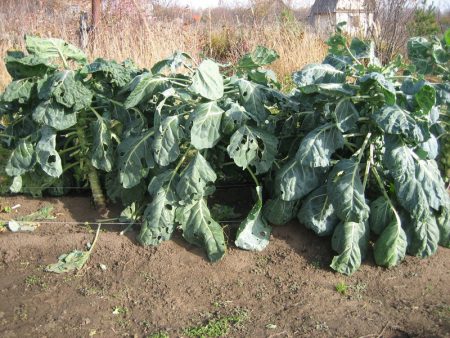

The optimal timing for planting seed for seedlings is from March 10 to April 5. From the moment of sowing seeds to planting seedlings on the beds, 35-45 days pass. The seedlings are transferred to open ground when they have 5 leaves. Planting in the garden is carried out from May 10 to June 5.
Dates of sowing seeds in open soil:
- Early ripening varieties: June, Golden hectare, Express, Transfer. The seeds are sown from 15 to 30 March. Cabbage has tender leaves, small heads of cabbage, vegetation period 110–120 days.
- Mid-season hybrids are suitable for harvesting for the winter and fresh consumption. Heads of cabbage are harvested 130-150 days after planting seeds. Hybrids: Symphony, Table, Slava 1305 and others are planted from March 20 to April 15.
- The growing season for late cabbage is 160-180 days. Varieties: Morozko, Garant, Arctic, Stone Head are planted on April 10-20.
Attention! Planting seed should be carried out 45-50 days before the planned planting in the ground.
The sowing time of the seeds depends on the region where the cabbage is planted. In the northern and western regions of the country, vegetables are planted through seedlings. Late varieties are grown only in greenhouse conditions, since they do not have time to ripen before frost.
How are Brussels sprouts planted?
Brussels sprouts can be grown in two ways - by seedling or by sowing seeds in open ground. Each method has its pros and cons; you have to choose a landing option taking into account the climatic characteristics of the region and your own preferences.
Seeds
Sowing seeds in open ground is used less often than the seedling method. It is beneficial for mass cultivation, since it avoids two stages at once - picking and transplanting into open ground. But the harvest, with this method, is obtained later.
Seeds are sown quite early - in March-April. They are guided by the temperature of the soil - it should warm up to + 10-15 ° C. Seeding procedure in open ground:
- On prepared beds, make shallow rows or holes for nesting. Planting depth - no more than 1.2 cm.The distance between adjacent seeds is 15 cm.
- Cover the crops with foil - so that the seeds begin to develop faster.
- When the seeds germinate, thin them out, choosing the sturdiest sprout. Pull the rest so that the cabbage has room for development. There should be 50 cm between adjacent plants.
Early and mid-season varieties are sown in open ground, with a growing season of no more than 120 days.


Seedlings
Any kind of cabbage does not tolerate transplanting well, and Brussels sprouts are no exception. Therefore, seedlings are grown in separate glasses - so that when planting in the ground, simply transfer a clod of earth with roots into a prepared hole - this reduces stress for the plant.
For growing seedlings, special cassettes or glasses are used. The volume of the container for one seedling is 200 ml. The order of growing seedlings:
- Fill any selected container - cassettes, glasses or seedling boxes - with the substrate. If boxes are used, make seed grooves in the soil. The depth of the rows or holes is 1 cm.
- Pour warm water over the soil.
- Sow the seeds, placing them at 0.5-1 cm intervals.
- Sprinkle soil over the seeds and compact it gently.
- Cover crops with transparent material - glass or foil.
- Place containers with crops in a warm place - to quickly get seedlings.
- After emergence, remove the film or glass. Move the seedlings closer to the light. The optimum daytime temperature is + 20 ° C, the nighttime temperature is not lower than + 16-18 ° C. Such a temperature regime will not allow the seedlings to stretch beyond measure.
- Care for the seedlings according to the following plan:
- Water as the soil dries. Too frequent watering of Brussels seedlings is contraindicated.Check the humidity at a depth of 1-1.5 cm. Water the seedlings preferably through a strainer so that the soil does not wash out.
- For the prevention of black leg, pour the seedlings with "Fitosporin" or a pink solution of potassium permanganate. Also, the soil can be sprinkled with wood ash, with colloidal sulfur previously added to it.
- If you sowed seeds in common containers, and not in separate glasses, there is one more step to be done - picking. Its essence is seating in separate containers. Dive the seedlings after the first true leaves appear. You will need a small peg - with its help, take out the grown seedlings - take them out together with a lump of earth and pinch the root. Deepen the seedlings to the first true leaves - if they plant the seedlings deeper, the stems can rot.
- Water the spiked seedlings well and put in the shade. The optimum air temperature is 20 ° C. When the growth of the seedlings is active, place them in the light. But it should be cool here - no more than + 16-18 ° C. Such conditions contribute to the formation of a strong root system.
- When the daytime temperature reaches + 10 ° C, start hardening the seedlings from 5-10 minutes, take out the seedlings at noon. When the seedlings get used to the sun, it will be possible to take it out in the morning and keep it there until 16-17.
It is impossible to overexpose seedlings - too large seedlings take root worse, grow slower and give lower yields. Seedlings are planted when 3 or 4 true leaves appear on it. Seedlings should be completely healthy, dark green in color.
After the appearance of 2-3 true leaves, feed the seedlings with a solution of "Kemira-Lux" (dissolve 1-2 g in 1 liter of water). Try to keep the liquid out of the leaves. Feed the seedlings for the second time 1.5-2 weeks before planting in open ground - add a solution of boric acid and copper sulfate (for 10 liters of water, take both at the tip of a knife).
The procedure for planting seedlings in open ground:
- Stop watering the seedlings in 4-5 days.
- When the soil warms up to + 10 ° C, the seedlings are planted in prepared holes. Plant according to the scheme 60x40-50 cm (between rows - 60 cm, between plants - 40-50 cm).
- Transplant the seedlings into the holes by the transfer method - remove the roots along with a lump of earth.
- Place the seedling in the holes so that the roots sit comfortably in it. The depth of the hole should be slightly more than the length of the roots. It is better that the stems are somewhat buried, rather than the roots being on the surface.
- Compact the soil thoroughly so that no air remains between the roots.
- Water the seedlings liberally.
We offer you to watch a video story of a gardener about how she grew Brussels sprouts in a seedling way:
Sowing seeds in the beds
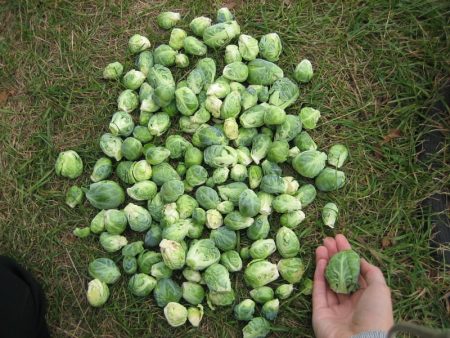

Seeds are sown immediately on the beds when the earth warms up to 15 degrees. For sowing, choose only early varieties of cabbage with a vegetative period of up to 130 days. It is necessary to have time to harvest before frost.
The seeds are planted in rows, in a nesting way. The seeds are lowered into the hole 2-3 cm deep, a gap is made between them 50 cm. They are carefully covered with earth and watered. You can plant 2-3 seeds in one hole. If there are a lot of seedlings, then the planting is thinned out, leaving strong, healthy seedlings. The row spacing is 50-60 cm.
Care features
Caring for Brussels sprouts is not difficult - standard agricultural techniques are used. But there are still differences with white cabbage - it is recommended to huddle and pinch the "Brussels".
How to water?
Soil moisture is maintained at 80%. Watering rules for Brussels sprouts:
- Water the plantings little by little, trying not to flood the growth point.
- When the planted seedlings take root and begin to grow, the plants are watered at the rate of 30 liters per 1 sq. m.
- To water the cabbage, furrows are made between the rows - water is poured into them, and when the water is absorbed, they are sprinkled with soil.
- During the growing period, the planting is watered several times. Moisturizing is especially important during the period of head formation.At high temperatures, the frequency of watering increases - cabbage is watered every 10 days.
- Waterlogging of cabbage is unacceptable - root rot may appear.
Watering rates for Brussels sprouts:
- before the appearance of heads of cabbage - 30-35 liters per 1 sq. m;
- after the appearance of heads of cabbage - 40-45 liters per 1 sq. m.
What and when to feed?
If the necessary fertilizers are applied before planting, then during the growth and development of the fruits, the cabbage can not be fed. But if the soils are poor or sandy, it is recommended to carry out a couple of supplementary dressings.
Composition and timing of top dressing:
| Top dressing period | Composition of dressings |
| Half a month after planting in the ground. The plant starts to grow, a new leaf appears. | Nitroammofosk. For one plant - 1/2 tsp. |
| Heads of cabbage began to form. | Potassium sulfate and superphosphate are dissolved in a bucket of water - 25 g each, and nitroammophoska - one tbsp. |
Top dressing is carried out on moistened soil so as not to burn the leaves and root system. After feeding the planting, the soil is slightly moistened.
Shaping
This simple agronomic technique allows you to increase the size and weight of the heads of cabbage growing on the stem of Brussels sprouts. It consists in shortening the shoots. Pinch the tops when the stem reaches a height of 60-70 cm. After pinching, the influx of nutrients to the growing heads of cabbage is activated - their growth and development is accelerated.
The shaping is carried out no later than August. Only late-ripening varieties and hybrids are subjected to it.
Hilling and loosening the soil
When the water is absorbed, the soil is loosened - this prevents the formation of a crust that prevents air from entering the root system. It is recommended to sprinkle cabbage several times during the growing season - the earth is raked in a thin layer, trying not to sprinkle the heads of cabbage located below.
It is recommended to mulch the planting of Brussels sprouts - this agricultural technique prevents the growth of weeds and the evaporation of moisture from the soil. Grass, straw or black film are used as mulch.
Care before harvest
About a week before the start of the harvest, all the leaves are removed from the cabbage. If the plants ripen together, the foliage is cut off at the same time. When the leaves break off, try not to damage the mini-heads. If the plants do not ripen amicably, then the procedure is carried out 2-3 times, tearing off the leaves only from those plants that are being prepared for harvesting.
Proper care of cabbage
Growing Brussels sprouts in the garden should be about the same as white cabbage. Plant requires regular watering, feeding, weeding and protection from diseases and pests.
Watering is of particular importance in growing crops, since Brussels sprouts love moisture. One square meter of the vegetable garden is watered with 30–40 liters of water. Approximately 8-10 waterings should be done during the entire growing season. When the heads of cabbage begin to form, the volume of water increases by about ten liters. In rainy weather, the frequency of watering is reduced.
If the soil in the garden is infertile, then the grown vegetable must be fertilized regularly:
- 7-10 days after planting, one teaspoon of nitrophoska is added under two plants.
- During the formation of heads of cabbage, a mixture of one teaspoon of nitroammophoska, 25 grams of superphosphate and the same amount of potassium sulfate is prepared. The mixture is diluted in a bucket of water and consumed one and a half liters per head of cabbage.
When growing cabbage outdoors, remember that this crop is often affected by cruciferous flea... To protect the plant from the pest, it is necessary to sprinkle the soil with wood ash before planting seedlings.
The main diseases and pests of Brussels sprouts
Brussels sprouts are affected by the same diseases as other cruciferous vegetables. The most common diseases:
- rot is white and dry;
- keel;
- blackleg;
- spotting is black and annular;
- bacteriosis mucous and vascular;
- mosaic;
- downy mildew.
Most often, the "Brussels" is affected by aphids, moths, cabbage fly, and also:
- cruciferous flea;
- cabbage leaf beetle;
- flea - wavy and black;
- cabbage white;
- moth;
- rapeseed and cabbage bug;
- bear
- scoop;
- wireworm;
- rape flower beetle.
How to deal with diseases and pests of cabbage, read here.
The listed diseases and pests can significantly spoil the productivity of Brussels sprouts. If you do not take action, you can even be left without a crop. To prevent the defeat of cabbage, it is processed with folk remedies. If there is no result, you have to apply - chemical preparations for diseases and pests, respectively.
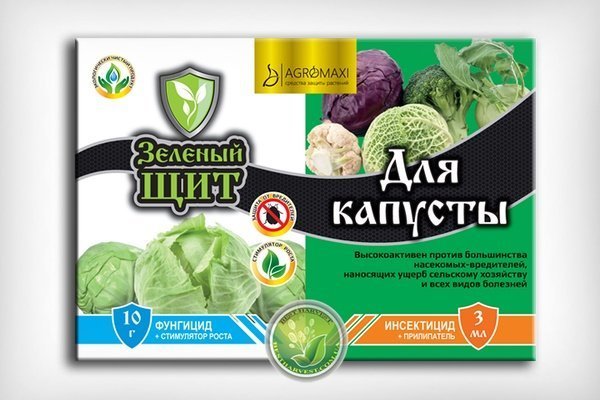

Prevention is cheaper than dealing with the consequences, so it makes sense to take preventive measures. Brussels sprouts defense strategy:
- Compliance with crop rotation.
- Cleaning of plant residues from beds.
- Regular weed removal.
- The use of a combination of organic and mineral dressings. You can not neglect the latter, limiting ourselves to one organic matter.
- At the first manifestations of the disease, the plant is pulled out, and the soil is watered with a solution of potassium permanganate.
- Sprinkling the beds with tobacco and woody evil.
- If pest attacks are observed, they are sprayed with "Decis", "Karate", "Corsair", "Rovikurt", "Ambush" and others.
- If fungal diseases appear, cabbage is sprayed with Fundazol, Quadris, Skor, Topaz and others.
Diseased plants should not be placed in compost - they must be burned immediately.
Growing Brussels sprouts from sowing to harvest
If you previously planted a white-headed beauty in your garden, then you can cope with the Brussels one. In order to collect a decent harvest in addition to a new experience when planting an interesting plant, and not waste time fighting cabbage diseases and pests, it is worth learning a few simple rules. One of them is the mandatory observance of the crop rotation process (planting shift). You can return any variety of cabbage to where it grew in 4-5 years. The annual use of one corner of the garden for cabbage crops will lead to soil depletion, the accumulation of pathogenic bacteria and viruses, and as a result - an outbreak of diseases, poor plant growth, and small yields.
Fundamental rules:
- You need to sow seeds at the end of March., can be in containers on the windowsill or in the greenhouse.
- The agrotechnology of growing seedlings is simple: rare abundant watering, protection from pests (it is necessary to process in a timely manner, since the cruciferous flea is capable of destroying all seedlings in a day). It is best to overdo it by dressing the seeds before sowing with a special compound (for example, "Prestige" - 1 cube per half liter of water). Next, we just cut through the plants so that they do not stretch out. No picking is required!
- It is possible to plant in the ground already at a seedling height of 10 cm... She will already have 4-5 true leaves, by this time the roots are sufficiently developed.
How to impress your country house neighbors with a good harvest of Brussels sprouts? The cultivation technique of this species is similar to the white one:
- A well-drained, deeply cultivated land is required, the best option is types of loam.
- When planting, not rotted organic fertilizers should be excluded, and then watering with fermented herbal infusion, because with a direct hit of fresh organic matter, cabbage is capable of accumulating a large amount of nitrates.
- During the growing season, if the soil has been well prepared in advance, you can do without feeding at all, or arrange "nutritious days". A decade after planting seedlings, it is worth adding nitrogen fertilizers, and when tying heads of cabbage, focus on the phosphorus and potassium necessary during this period. Experts recommend using only mineral fertilizers.
When to start harvesting?
The harvest begins when the small heads of Brussels sprouts are fully ripe.Maturity is determined by the following criteria:
- the value reaches a maximum - 1.8-2 cm in diameter;
- heads of cabbage acquire a shine characteristic of ripe fruits;
- the leaf turns yellow at the base.
Features of harvesting early and late varieties:
- Early and early middle. Harvested in September-October. Harvested in one go, as their heads ripen at the same time. The stems can be cut at the base and stored for later harvesting.
- Mid-late and late. This category of varieties is harvested in 2 or 3 passes. Before harvesting, the leaves are cut off from the plants - only from the side on which the heads of cabbage are to be collected. When harvesting in several stages, the heads of cabbage are cut, starting from the bottom of the stem.
Growing seedlings of Brussels sprouts at home
Since almost six months pass from planting, the appearance of the first shoots to ripening and the moment of harvesting, this type of cabbage is sown with seeds and grown through seedlings. To get strong, sturdy seedlings you need:
- choose the best variety that meets the preferences of the gardener in terms of parameters: ripening period, taste, size range, color palette of leaves (this criterion is important when creating an ornamental garden)
- mix a soil substrate from non-acidic peat, humus, earth, sand and wood ash (it must be sifted). Garden soil is less suitable for seedlings of Brussels sprouts. Its cultivation on garden soil without additional disinfection (calcination) can lead to rot of immature seedlings, the spread of diseases among seedlings, and then to loss of yield
- follow the general rules for planting all cabbage species, observe the required distances (5 cm per seedling in diameter) and the sowing depth (1 cm).
- provide the necessary watering and light regime: if the temperature in the apartment is quite enough for the development of cabbage, then the light must be provided to the maximum. Daylight hours should be at least 12 hours, and the illumination should be intense. Therefore, choose windowsills on the sunny side. We water rarely, but abundantly. Don't forget about drainage: there must be holes in the bottom of our container.
- maintain the required temperature: during the day we keep the seedlings warm on the windowsill, at night we send the beauty to the glazed loggia. In this way, the required regime will be observed, and the plants will be hardened.
- fertilize with a solution of fertilizers. It is better to use liquid fertilizers diluted with water in the proportion intended for seedlings. This information is usually indicated on the packages.
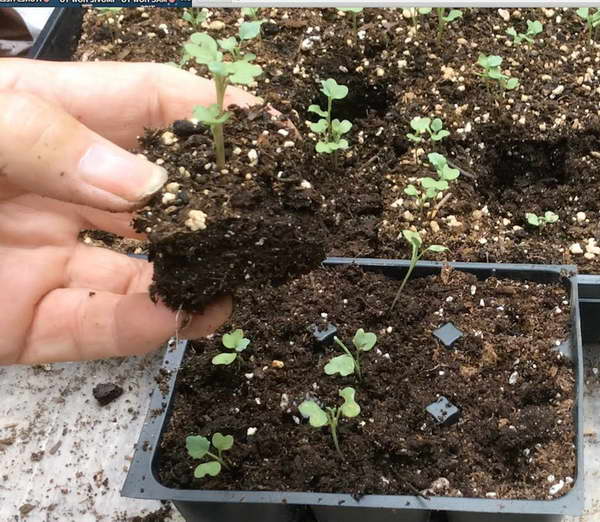

Brussels sprouts are very easy to grow at home
How do lunar phases affect the planting of Brussels sprouts when grown from seeds? When to plant seeds for seedlings? Any vegetables with an edible ground part are recommended to be planted on the "growing" moon. The optimal period is the end of March, the first ten days of April. A light, loose substrate is laid out in separate peat containers. The earth is slightly compacted, 3-4 seeds are planted in the hole at a short distance, sprinkled with a layer of earth up to 2 cm.When sprouts appear, you should watch their development, then cut off or pinch off less successful ones near the surface of the earth, leaving one for further growth. Do not pull the stems out of the soil - this will damage the root system of the selected specimen.
Storing Brussels sprouts
Brussels sprouts can be stored whole by consuming their cabbages as needed. The plant must be dug out before the frost begins, and dug in with sand in the basement and greenhouse room. Dip the cabbage at a slight slope. Also, the stems with fruits, folded in plastic bags, are stored in the refrigerator,
Frozen Brussels sprouts can be stored for 3-4 months.
Having folded the harvested crop in boxes, they are placed in a cool place. If they are kept at 0 ° C, they remain fresh for up to 1.5 months.And if you freeze them, then they will retain their qualities throughout the winter. We recommend storing Brussels sprouts at 0 ° C and 95% humidity. Under these conditions, cabbage is stored for 2-2.5 months.
Due to the peculiarities of cultivation, Brussels sprouts have not yet received proper distribution among our vegetable growers and gardeners. But with the advent of new varieties and hybrids - more productive and less demanding, the demand for this crop will grow. This vegetable has so many virtues that it is simply unforgivable to neglect it.
0
Landing in open ground
From about mid-May, when four to five true leaves appear on young plants, their can be planted in the garden... The site is chosen well-lit, with loamy fertile soils.
Varieties, useful properties and contraindications of marjoram
It is recommended to grow Brussels sprouts after onions, cereals, legumes, cucumbers, carrots, potatoes. Only four years later, the vegetable can be planted in the beds where beets, tomatoes, daikon, radishes, radishes, turnips, turnips, cabbage grew.
The site for planting a vegetable should be prepared in the fall. It is dug onto a shovel bayonet and a bucket of humus or compost is added for each square meter. In the spring, before planting, holes of 60x60 cm are made, into which two glasses of ash and two tablespoons of superphosphate are added. Seedlings are placed in the soil mixed with fertilizers, along with a clod of earth from the pot. The plant roots are covered with earth, which is watered and compacted.
Parasites and diseases
Brussels sprouts have strong immunity. It is exposed only to those diseases and pests that affect other crops of the cruciferous family. That is why it is strictly forbidden to plant it on the site where other types of cabbage, as well as radishes, were previously grown.
Perhaps the most dangerous pest is the cruciferous flea. Also, Brussels sprouts are attacked by babanukha, aphids, moths, sprout flies, cabbage whites, black and wavy fleas. Less often, but still, the vegetable is sometimes struck by the wireworm, bear and scoop. Some parasites do not cause serious damage, while others can “pervade” so much that the plant will not bear fruit or even die.
You need to fight pests even before they appear, that is, take preventive measures. This is much more effective than the use of special pest control products. Good prevention will provide the cabbage with immunity, and no parasites will be afraid of it.
It is necessary to adhere to the rules for the selection of seeds, correctly and successfully carry out agrotechnical work. Before planting, the soil must be cultivated without fail. Similar manipulations must be done with the seeds before sowing. In no case should you leave the remnants of last year's plants in the garden.
If, nevertheless, pests have appeared on cabbage, it is necessary to get rid of them with folk remedies. It's better to start with this. They are harmless to plants and humans. If folk remedies do not help destroy parasites, then it is already worth seeking help from chemicals. Stop the choice on bacterial insecticides: there will be less harm to plants from them. For the fight against parasites, "Poliram", "Median Extra", "Ditan", "Coside", "Connect", "Bi 58", "Proteus", "Borey", "Karate Zeon", "Zolon", "Voliam" Flexy "and others.
Growing Brussels sprouts is easy. It is necessary to follow all the rules for the preparation of seeds, soil, site selection, and also properly care for the plants. You should carefully monitor the seedlings, feed them, water them regularly. In this case, the plants will be strong, and the yield will be large.
Harvest time
The harvest time for Brussels sprouts begins in mid-October. Heads of cabbage are cut out gradually as they ripen. After a small frost, the taste of cabbage heads increases.Ready-made heads of cabbage are dense, at least 3 cm in diameter. Frozen Brussels sprouts are stored in the freezer. Brussels sprouts have such a property as ripening. Together with the main stem and roots, the cabbage is dug up and transferred to the basement, where it is added with damp earth. And for another two months, the plant will gain weight due to the redistribution of nutrients from the leaves and trunk. In cooking, small heads of cabbage are boiled, stewed and fried and used fresh.
(read more ...) :: (at the beginning of the article)
| 1 | 2 |
:: Search
Unfortunately, errors are periodically encountered in articles, they are corrected, articles are supplemented, developed, new ones are being prepared. Subscribe to the news to stay informed.
If something is not clear, be sure to ask! Ask a question. Discussion of the article.
More articles
Miners or miners. Punctures, whitish dots. White, brown ... How to identify a minefly infestation. How to identify the disease and cure ...
Peking (Chinese) cabbage (petsai) - cultivation. Soil, soil, ra ... How to plant and grow Peking cabbage. How to care for a plant. Agrotechn ...
Salt the eggplants. Canning. Recipe. Salting, salting, salting, salting ... Canning eggplants for the winter. Salting recipe. Salting technology. Method p ...
Knitting. Openwork mosaic, transverse openwork. Drawings. Patterns patterns ... How to knit the following patterns: Openwork mosaic, transverse openwork. Detailed tool ...
Knitting. Openwork tulips, elegant openwork. Drawings. Patterns patterns ... How to knit the following patterns: Openwork tulips, elegant openwork. Detailed inst ...
Knitting. Evening breeze. Drawings. Patterns patterns ... How to knit a pattern - Evening breeze. Detailed instructions with explanations ...
Knitting. A family of spiders. Drawings. Patterns patterns ... How to knit the following patterns: A family of spiders. Detailed instructions with an explanation ...
Plant diseases. The tree, the bush wither, get sick, dry, the foliage falls off, ... The plant is sick. How to define a disease? Species, types, classification grow ...
Summary
To the section `Life outside the city`
Privacy Policy
Photo
Check out the photo of Brussels sprouts.
Pests
The most common enemies of Brussels sprouts are aphids and bears, as well as numerous species of caterpillars. Aphids can be fought with the help of ash, which she is afraid of. To do this, you need to spray a small amount of it on the surface of the plant. Bears that destroy the root system of a vegetable can only be destroyed by microbiological preparations. To combat caterpillars, you can use insecticides at a time when butterflies begin to fly (primarily cabbage, which are well known to everyone).
Diseases, pests
Although this type of cabbage culture is distinguished by its unpretentiousness and stability, it still does not tolerate a disdainful attitude towards itself. Due to insufficient care, there is a threat of the development of diseases. Also, at any stage of development, the culture can be affected by flying harmful insects. Therefore, you need to regularly inspect the plants.
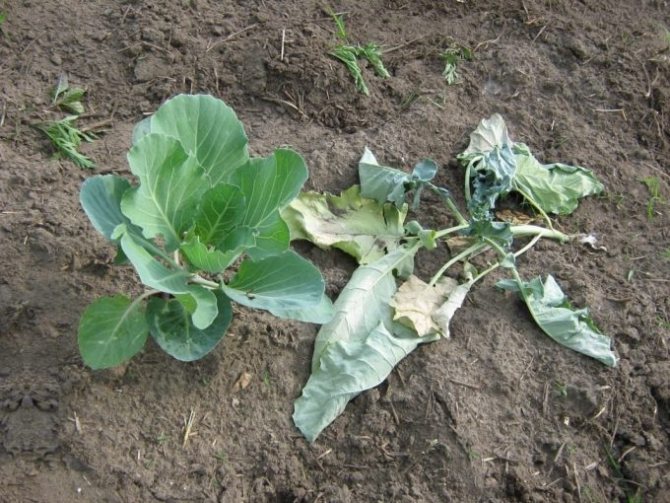

The main signs of damage to Brussels sprouts by diseases or pests:
- Fusarium. Fungal disease mainly affects the deciduous and stem parts of the plant. Cabbage has a contrasting color change. Green varieties become golden, burgundy ones become gray-brown in color. The plant withers.
- Powdery mildew. Cabbage leaves are covered with a thin white bloom. This is usually due to excess air humidity.
- Viral or bacterial infection. Most often, the disease affects a weak adult plant or young seedlings. On the tops, vascular patterns with the inclusion of black and yellow specks are visible.
- Cabbage keel. Of all diseases, this is the most dangerous. It affects many species of plants belonging to the cruciferous family. In this case, the deformation of the root system occurs, as a result of which the culture begins to dry. The growth and maturation of the heads of cabbage stops.
- Scoop. The larvae of cabbage, garden or winter moths adore the flesh of the stems. Sometimes they can gnaw right through it from the inside.
- Medvedka. Larvae or imago of this insect dig numerous passages in the surface layer of the soil. As they advance, they simultaneously eat the young roots of the plant.
- Aphid. Cabbage leaves can be covered with small midges. From the outside, these islets of gray-green color resemble mold.
- Cabbage fly. It is the larvae of this insect that are dangerous for the plant. An adult lays eggs under Brussels sprouts. In the course of their development, the larvae begin to feed on green tops.
- Fleas (earthen). If you notice a lot of tiny tiny holes that turn foliage into a sieve, then earthen fleas have started. Insects attack only young plants, the rough peel of an adult cabbage cannot be overcome by jumping insects.
- Cabbage butterfly. If you turn the leaf over, then under the bottom you can see eggs laid in groups. This is the offspring of a cabbage butterfly. When the larvae hatch, they move to the foliage and eat it.
If preventive measures are taken to prevent the formation of diseases and attacks of harmful insects, then Brussels sprouts can be saved.


Preventive action:
- Before planting work, it is imperative to disinfect the seeds.
- Monitor the acid-base rate of the soil composition. Pathogenic flora develops faster in an acidic environment.
- After watering and rains, loosen the soil. Timely remove weeds from the garden plot.
- Take into account adjacent crops when planting.
- In autumn, after harvesting, plow the soil.
Popular: Ways to store carrots in winter so they don't rot
If detected, it is recommended to use non-toxic agents:
- Naphthalene, Proteus, wood ash - destroy butterflies and larvae
- Herbal infusions of thyme, chamomile, ash, the plant is treated from aphids
- Wormwood decoction, powdered boric acid will save from the invasion of earthen fleas
- Fundazol, Trichodermin, baking soda - for fungal diseases
- Medvedtoks, kerosene or soapy water, oil will help drive the bear out of the garden.
Leaves damaged by disease or pests should be removed. If the entire bush is affected, then it is completely uprooted. If Brussels sprouts have been affected by keel or viral diseases, then it is not recommended to plant cruciferous crops in this area for several years.


When and how to harvest?
Attention!
Harvesting, depending on the length of the growing season, variety or hybrid of Brussels sprouts, begins in late August and ends in late autumn.
You can harvest:


- at a time;
- gradually.
The second option is preferable, since starting the harvesting from the bottom, they make it possible to ripen the upper heads of cabbage.
Massively fruits begin to be harvested after the axillary leaves fall off... The palatability of cabbage is improved if the crop is harvested after the first frost.
Contraindications to use
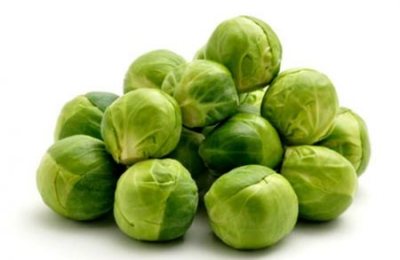

This the product should be used with caution by people suffering from flatulence and with reduced thyroid function... Contraindicated in case of individual intolerance and people with irritable bowel syndrome.
People taking blood thinners should not consume Brussels sprouts during this period.
Diseases, pests and control of them
Diseases and pests are the Achilles' heel of most cabbage varieties. Brussels is no exception in this regard. Therefore, it is imperative to carry out pre-planting seed preparation, observe the planting scheme and do not forget about crop rotation.
Of the pests, the most dangerous for the culture are:
- Cruciferous flea. Adults and their larvae feed on plant tissues, turning cabbage leaves into a sieve in a matter of days. After that, they dry quickly, the plant dies.At the first signs of a pest, the cabbage is sprayed with vinegar essence diluted with water (15 ml per 10 l). If there is no effect, the drugs Aktellik, Aktara, Foksim are used. Practice shows that any kind of lettuce, planted in the aisles, repels the pest.
- Cabbage fly. The larvae of the pest settle on the roots of the plant, eating them from the inside. Then they pass into the stems, in which long "tunnels" are also made. For prophylaxis, the soil is powdered with a mixture of tobacco dust, sifted wood ash and ground pepper, taken in approximately equal proportions, a week and a half after planting the seedlings in the ground. To scare off adults from planting, they are sprayed with infusion of tansy or celandine. In the event of a mass invasion, Ambush, Rovikurt, Corsair are used.
- Caterpillar of a cabbage scoop. Large grayish-beige caterpillars gnaw at the leaves, starting from the edges. In just 2-3 days, only veins remain from them. The plant dries up and dies. For prevention, the soil in the garden is regularly loosened, cabbage is sprayed with foam of green potash or laundry soap, infusion of wood ash. Adults are destroyed by luring them with the help of pheromone or homemade traps (deep containers with honey, jam, sugar syrup diluted with water). They are scared off by the drugs Lepidocid, Bitoxibacillin. To combat the larvae, plants and soil in the garden are sprayed with a solution of Fufanon, Aktellik, Belofos, Talkord.
- Aphid. Almost all garden crops suffer from this pest to one degree or another. Aphids attack plants with whole colonies, literally clinging to the inside of the leaves, the top of the stem, and the ovary of the heads of cabbage. She feeds on plant juices. The affected tissues are covered with small dots, clearly visible in the light, the leaves are deformed and dry out. The pest is scared away from Brussels sprouts by spraying it with infusions of greens of any plants with a pronounced pungent odor. Orange peel, dry tobacco leaves, ground red pepper, mustard powder have a similar effect. Processing is carried out every 5-7 days, if the aphid has already appeared on the plant - 3-4 times a day. In the event of a mass invasion of a pest, any general-purpose insecticides are used - Inta-Vir, Calypso, Fury, Iskra-Bio, Commander.
- Snails and slugs. They feed on plant tissues, eating large holes in the leaves and heads of cabbage. A layer of sticky silvery coating remains on the surface. Young seedlings can be completely destroyed. The keeping quality of damaged Brussels sprouts drops sharply, and you don't really want to eat it. A massive invasion of slugs is a rare phenomenon. Only in this case it is necessary to use chemicals (Meta, Thunderstorm, Slime-eater), in all the rest it is quite possible to do with folk remedies. Slugs are lured with the help of traps by digging cut plastic bottles or other deep containers into the ground, filling them with beer, fermented kvass, pieces of cabbage or grapefruit. Individual pests can be collected manually - they have no camouflage abilities in principle, they also do not differ in speed of movement. The plant stems are surrounded by "barriers" of coarse sand, spruce needles, ground eggs or nutshells.
Photo gallery: what pests dangerous for Brussels sprouts look like
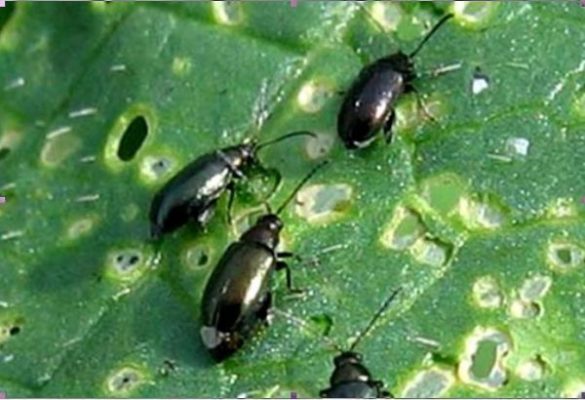

The cruciferous flea affects not only all varieties of cabbage, but in general any plants from the Cruciferous family
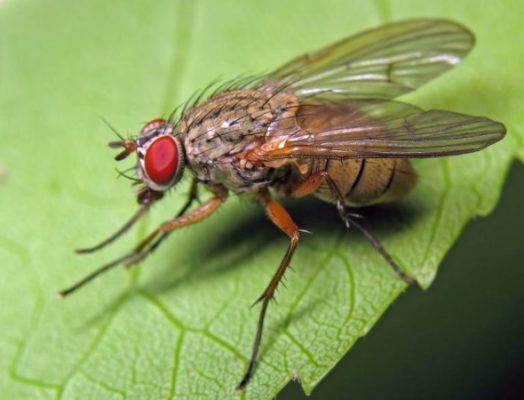

It is almost impossible to find cabbage fly larvae, but they cause significant damage to plants.
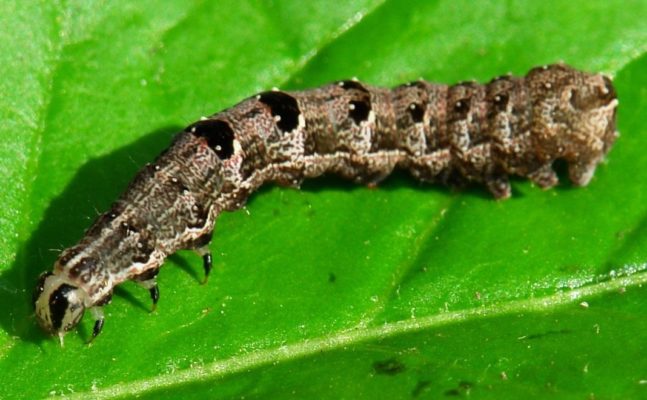

The main harm to cabbage is caused by the caterpillars of the cabbage scoop, but adults also need to be fought with.
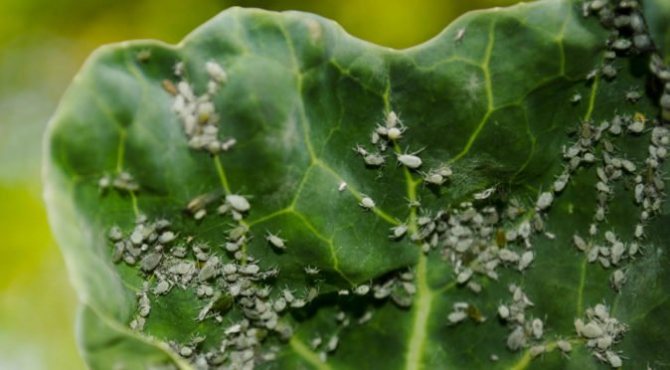

Aphids are one of the most "omnivorous" pests affecting garden crops, cabbage is also subject to its attacks


Slugs greatly spoil the appearance of cabbage heads, the damage caused by them also does not affect its keeping quality
Of the diseases, Brussels sprouts most often suffer from fungi.Before planting, seeds must be pickled in a fungicide solution. But this does not give a 100% guarantee of protection against infection, especially if planting care cannot be called ideal. Most often, Brussels sprouts are attacked by the following diseases:
- Keela. Ugly growths appear on the roots, similar to tumors. On the aerial part of the plant, the fungus does not appear in any way. It seems that cabbage stops developing and dies for no reason. Observance of crop rotation is very important for the prevention of the disease. The plant affected by the keel can only be pulled out and burned as quickly as possible, thus eliminating the source of the infection. For disinfection, the soil in this place is spilled with a solution of copper sulfate or Bordeaux liquid (0.5 liters per 0 liters of water).
- White rot. The fungus grows especially well in acidic or nitrogen-saturated soil. Leaves and heads of cabbage are covered with a layer of white bloom, similar to peeling paint. Gradually, it darkens, the affected parts stop growing and deform, the tissues turn brown and rot. At a late stage of development, the disease cannot be treated. If it has affected only individual leaves so far, the infected tissue is cut out, the "wounds" are washed with 2% copper sulfate, and powdered with activated carbon is sprinkled. The soil is spilled with a solution of any fungicide.
- Dry rot. Leaves and heads of cabbage are covered with light grayish-beige spots with small black blotches. The inside of the leaf takes on an unnatural purple color. The affected tissues are cut out with a sharp knife, the plant is treated with Thiram, Fitosporin-M.
- "Blackleg". The disease affects seedlings and develops very quickly. If you do nothing, you can lose your crop already at this stage. The base of the stem turns black and softens, the plant wilts and dries. To protect the seedlings, crushed chalk or wood ash must be added to the seedling soil. At the first signs of the development of a fungus, watering is reduced to the required minimum, the water is replaced with a solution of potassium permanganate of light pink color. Seedlings and substrate are sprayed with Fitosporin-M, Fitolavin, Baktofit. When transplanting cabbage into a garden bed, Trichodermin or Glyocladin in granules is added to the hole.
- Peronosporiosis (downy mildew). The front side of the sheet is covered with yellowish blurry spots, the wrong side is covered with a continuous layer of ash. Affected tissues turn black and rot. To avoid fungal attack, the soil in the garden is sprinkled with wood ash, colloidal sulfur, tobacco crumbs. In the early stages of the development of the disease, it is quite possible to cope with it with folk remedies - soda ash diluted with water, laundry soap foam, a bright pink solution of potassium permanganate. If it was not noticed on time, fungicides are used - Alirin-B, Topaz, Horus, Baikal-EM and so on. There are also means that have been tested by more than one generation of gardeners and have proven their effectiveness - Bordeaux liquid and copper sulfate.
- Alternaria (black spot). The leaves are covered with small gray-black spots, gradually turning into concentric rings. Then they quickly wither and dry. Prevention and control measures are the same as for peronosporiosis.
Photo Gallery: Symptoms of Diseases Typical for Brussels Sprouts
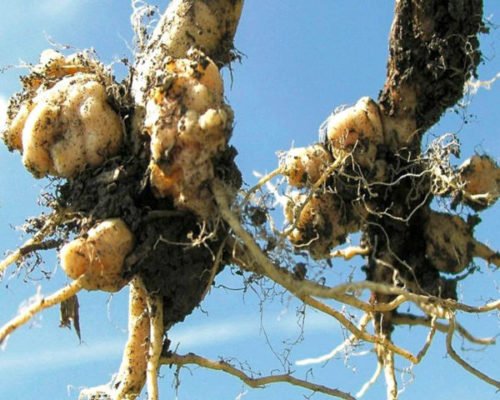

Keela cabbage cannot be found until the plant is dug out of the ground.


Overfeeding of cabbage with nitrogen contributes to the development of white rot, and the fungus also feels very good in acidic soil
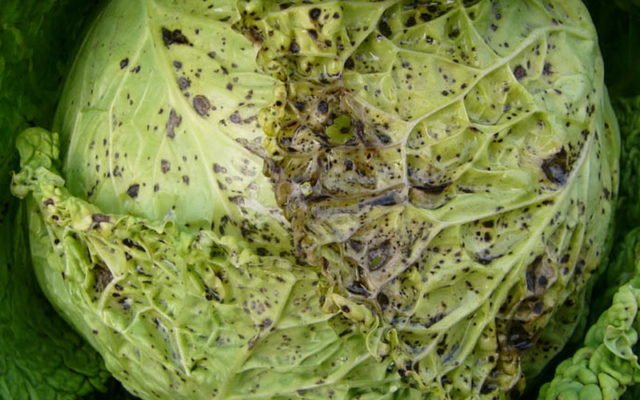

Dry rot most often develops during storage, but cabbage in the garden is also not immune from it.
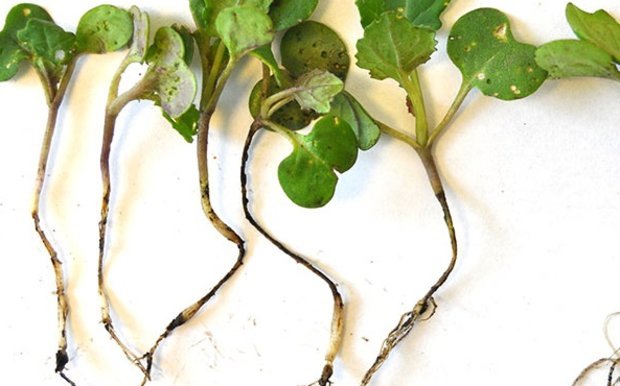

"Black leg" affects not only cabbage, but in general any seedlings, the disease develops quite quickly, so measures must be taken immediately
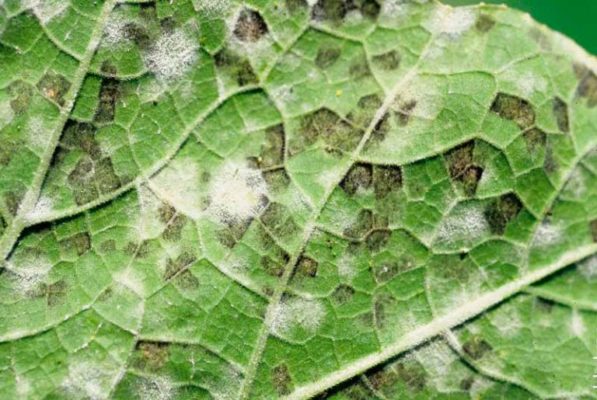

The plaque that appears on the leaves during the development of peronosporiosis seems harmless, but in fact it is a symptom of a dangerous disease. Any fungicides are used to combat Alternaria - the fungus does not tolerate copper compounds
Topping
To accelerate the ripening of this outlandish vegetable will help such an agrotechnical technique as pinching, or, as it is also called by gardeners, punching. There is nothing difficult in this procedure. Do everything in stages.
- As soon as the lowest heads of cabbage grow up to 1.5 cm in diameter (in different regions - these are their own terms, for example, in the central one - this is the end of August), then it is necessary to remove (pinch, as they say in another way) the very top of the vegetable. You must remove the growth point. You can also remove a few leaves from the topmost rosette.
- A month and a half later, you can completely cut off the top of those plants on which heads of cabbage are very poorly tied.
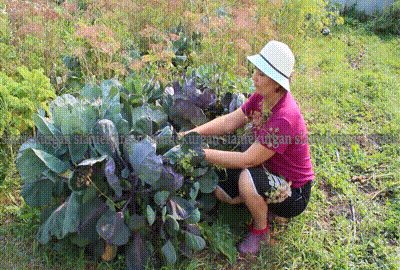

Advice! Before pinching the plant, it is advisable to feed them with useful infusion. To prepare it, you need to take a bucket of water and 30 g each of superphosphate and potassium sulfate. Everything needs to be mixed well. Water 1.5 liters under each bush. In this case, the heads of cabbage will be denser.
Planting seedlings
The unpretentious, frost-resistant Brussels sprouts, in comparison with their relatives, have the longest vegetative period - it is 120-180, and some varieties even more than 180 days. This feature entails the need to grow it, mainly through seedlings.
The start time of the growing process directly depends on the temperature and the selected seed variety. The optimal period for early middle varieties is mid-March, middle-late ones - early April.
A particularly important point in growing seedlings is seed preparation. For this:
- the seeds are kept in a damp cloth for 5 days;
- heated in hot water (500 C) for 20 minutes;
- then dipped in cold water, soaked for 10 hours. in manganese solution;
- washed after potassium permanganate, they are placed in a refrigerator for a day;
- at the end of the day, the seeds that have passed the preparation process are dried.
For sowing seeds, a soil mixture is prepared, consisting of: peat, sod land, sand, wood ash mixed in equal proportions with the addition of mineral fertilizers. It is undesirable to use the land from the garden and humus - there is a danger of infection with a black leg.
The containers are filled with the prepared soil, poured with a manganese solution and the grooves are pushed to a depth of 1.5 cm with an interval between rows up to 10 cm. The seeds are laid out in grooves at a distance of ~ 4 cm from each other, covered with soil slightly, pressing down. The container is covered with glass or cellophane to create a greenhouse effect.
Seedling care
The sown seeds are kept in containers in a room with a temperature of up to 200 C, the soil, if necessary, is sprayed with water. The first shoots will appear in a week.
With the appearance of the first true leaf on day 9, the plant requires special care, it consists of:
- picks - transplanting shoots to a new place. For this, separate cups are prepared, pots or more spacious containers are filled with fresh soil mixture, poured with a manganese solution;
- seedlings, together with a lump of earth, are carefully transplanted to a new prepared place, deepening it in cotyledonous leaves;
- watering seedlings with warm water and loosening the earth;
- 2-stage feeding. The first (foliar) should be carried out after the development of 3 true leaves. The solution is prepared from 10 liters of water, superphosphate (40 g), potassium sulfate (10 g). The second is carried out after 2 weeks, for it superphosphate (60 g), potassium sulfate (20 g), ammonium nitrate (30 g) are dissolved in 10 liters of water. Fertilizers are applied to watered soil;
- humidity control to prevent overflow, which can lead to blackleg disease.
Seedling hardening
Before planting Brussels sprouts in the garden, it must be hardened. To do this, you need to provide access to it for atmospheric air.If the seedlings are grown in the house, then they are taken outside. The hardening process is carried out for 15 days, starting from 0.5 hour with an everyday increase in time until the very landing on the prepared site.
To grow Brussels sprouts in the open field, you need to decide on the timing of its planting. Seedlings of Cassio Brussels sprouts, should be grown from early April until the end of the next month. This time will be enough to get quality seedlings. In Siberia, planting is recommended a few months later.
The agricultural technology for planting seeds is quite simple. It must be planted in small containers, no more than 5-7 cm deep. It is necessary to add the soil mixture that was prepared earlier to each of the containers. After that, the whole earth is watered with potassium manganese solution and infused for 5-10 minutes.
Then they begin to make holes for planting seeds. Their depth should be about 1 cm, and their width should be 2-3 cm. When all the seeds are planted, the holes are sprinkled with a small layer of earth and watered with heated water. Then all containers are covered with plastic wrap and transferred to a bright room. They are opened only after the first shoots appear.
Outdoor cultivation of Brussels sprouts should be carried out in the second half of spring, when the outside temperature will always be above freezing.
Planting Brussels sprouts seeds in a garden and preparing for it
Directly in the garden, seeds of Brussels sprouts with the expectation of obtaining a crop in Russia can only be sown in the Black Sea region. Sometimes early varieties can be grown in the Moscow region, but only if the weather is very lucky in spring and summer. And gardeners try not to risk the future harvest.
Even a slight shading of the culture reacts negatively, the heads of cabbage either do not form at all, or they turn out to be very loose. Therefore, an open place, well-lit and warmed by the sun, is taken under a garden bed with Brussels sprouts.
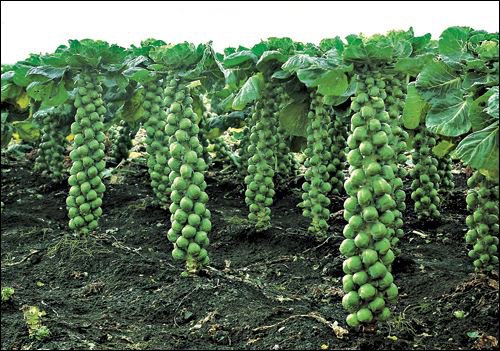

Brussels sprouts do not tolerate even light partial shade, they choose an open area for it, which is illuminated by the sun for most of the day
This culture prefers a fertile, but at the same time rather loose substrate with a neutral acid-base reaction. The ideal option for her is loam. As practice shows, such soil is freed from snow faster in spring and warms up to the desired temperature.
Recent Entries
Rose Petal Jam and Its 7 Health Benefits You Likely Didn't Know About What Fruit Are You According to the Zodiac Sign 11 Best Grape Varieties That Will Help You Create Unique Homemade Wine
Brussels sprouts are less demanding on the quality of the soil than white cabbage, but in a "heavy" substrate it will not grow and develop due to insufficient aeration of the roots, and from light sandy soil it will simply turn out rather tall and massive plants, despite a well-developed root system.
Good predecessors for Brussels sprouts are plants from the legume family, any root vegetables (except beets), onions and garlic, and herbs. Green manure is also suitable, loosening the soil and saturating it with nitrogen. But after other representatives of the Cruciferous family (cabbage, radish, radish, daikon) and Solanaceae (tomatoes, peppers, eggplants, potatoes), it can be planted no earlier than in 4–5 years.
A garden bed for Brussels sprouts has been prepared since autumn. It is dug to a depth of one bayonet of a shovel, while simultaneously bringing in 8-10 liters of humus per 1 m². Of the fertilizers, only potash and phosphorus fertilizers are needed (15–20 g / m² and 30–40 g / m², respectively). Instead of mineral dressings (superphosphate, potassium sulfate), wood ash (0.5 l / m²) can be used. Excessive acidity is neutralized with dolomite flour or eggshell crushed to a powder. They also saturate the soil with calcium, the need for which is very high in Brussels sprouts.
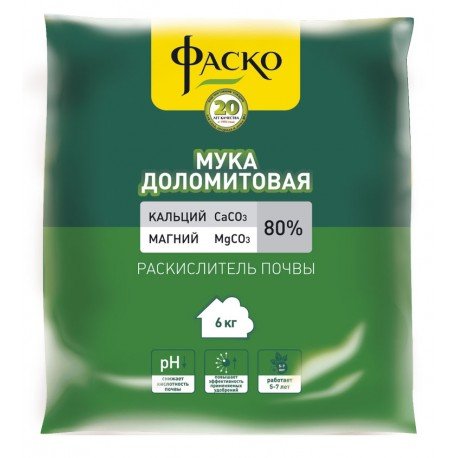

Dolomite flour is a natural soil deoxidizer, if the dosage is observed, it has no side effects
In the spring, about 7-10 days before planting the seeds, the soil in the garden should be well loosened and spilled with a solution of potassium permanganate of bright crimson color or any fungicide for disinfection. After that, it is tightened with a black film, which is removed only before planting. It is strictly forbidden to introduce fresh manure in the spring. This greatly inhibits the formation of heads of cabbage.


Wood ash - a source of potassium and phosphorus
Seeds are sown in the ground in the second decade of April. By this time, the temperature at night should not drop below 5 ° C. The daily indicator is at least 18 ° C. For them, exactly the same pre-planting preparation is carried out as described above. They are sown in the soil, deepening a maximum of 1–2 cm, with the same interval as the seedlings. Put 2-3 pieces in each hole. From above, the seeds are sprinkled with peat chips or humus, until the seedlings appear, the bed is covered with a film. This usually takes 7-10 days.
Care for seedlings in the open field is not much different from what is required for seedlings of Brussels sprouts. But there are also some differences. The soil in the garden should be weeded regularly. For protection from direct sunlight, cabbage is kept under a canopy for about a month or a half or covered with spruce branches, old buckets. Water it more moderately, once every 5-7 days. Two weeks after germination, the garden bed is sprinkled with tobacco dust or ground red pepper to protect them from cruciferous flea beetles. Or you can treat plants and soil with any drug recommended to combat it.
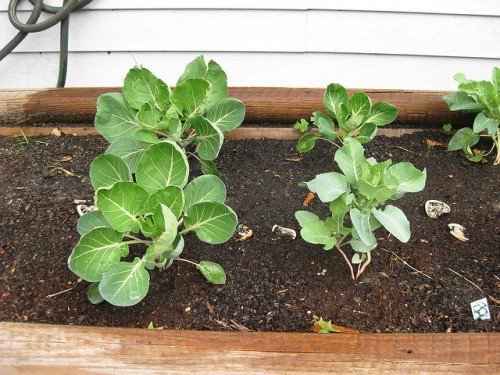

Seeds of Brussels sprouts in open ground are planted in several pieces per hole, then the shoots are thinned
In the phase of the second or third true leaf, the seedlings are thinned out, leaving only one plant in each hole, the most powerful and developed. Unnecessary are cut with scissors or pinched at the very soil. You cannot pull them out so as not to damage the roots of the selected specimen.
Question answer
Why isn't Brussels sprouts tied?
There may be several reasons for this.
Reason 1. Substandard change. It so happens that the seed plant interbreeds with its cruciferous cousins. As a result, a hybrid is obtained in which no heads of cabbage are tied.
Reason 2. You overfeed the plant with nitrogen. Everything went into green mass. It is possible that, on the contrary, you did not feed him at all, or your land is very poor.
Reason 3. The heat is intense. This cabbage does not like this weather very much.
Reason 4. You forgot to pinch the top.
Reason 5. You are not watering the plant well.
The cabbage has gone into bloom, what should I do?
If your cabbage has bloomed, there may be several reasons. First, it is heat and dryness. Usually this weather is in July. In this case, the cabbage needs to be watered and shaded frequently.
Secondly, it is possible that you have overfed the plants with organic matter. In this case, you need to stop feeding altogether.
Third, you may have overgrown seedlings. Therefore, you need to closely monitor the timing of planting. If Brussels sprouts have bloomed, trim off the flowering parts, shade, water more often.
Should you remove leaves from Brussels sprouts?
Many people ask the question: “When to pick leaves on cabbage. And is it really necessary to do this? " Experienced summer residents do not advise doing this. They can only be torn off if you want to keep the cabbage in the cellar. To do this, they dig it out together with the roots, break out the leaves (except for the apical ones) and drop it in the sand.
Why do the leaves curl?
- Insufficient watering and heat.
- Pest infestation (aphids and whiteflies).
- The plant may lack minerals or, conversely, there may be an excess of them.
- You can simply burn the plants if the proportions are not correct when preparing herbicides or fertilizers.
Why don't heads of cabbage form?
This culture is quite capricious in care and growing requirements.She does not like heat and dryness, when she is too overfed or not supplemented. In this case, the heads of cabbage may not form. Also, don't forget to pinch the top.
IMPORTANT! * when copying article materials, be sure to indicate an active link to the source:
If you liked the article - like it and leave your comment below. Your opinion is important to us!
Where to plant, choose a place
This outlandish-looking cabbage is very demanding on the choice of place and growing conditions. However, satisfying all her whims is not difficult at all. We will tell you how to grow Brussels sprouts in the country.
Rule 1
Plant only on fertile soil rich in humus and humus. She does not like heavy clay soil in the garden. By the way, experts cite the following facts: in just 1 season, from 1 hundred square meters of land, a vegetable takes out almost 2 kg of nitrogen, the same amount of calcium and half a kilogram of phosphorus. The numbers are very impressive. Accordingly, on poor and infertile soil, do not expect a harvest.
However, fresh manure should not be used at all stages of growth. As a result, you will only get a bunch of greens, and there will not even be a set of heads.
Advice! Prepare the ground for the vegetable in the fall. When you dig, be sure to put rotted manure or compost (5-6 kg per 1 square meter), as well as mineral fertilizers (2 tablespoons of potassium chloride, the same amount of ammonium nitrate and superphosphate, you can add 1 glass of ash instead of the latter).
Rule 2
The place for cabbage should be sunny and open, always protected from the wind. She loves the southern and southeastern areas.
Rule 3
Choose your predecessors correctly. The vegetable is best planted after potatoes, tomatoes, cucumbers, legumes, beets or carrots.
Planting
To understand how to properly plant cabbage at home, you need to familiarize yourself with the main features of this process. Planting is necessary only in the evening or on cloudy days, so that there are no bright sunlight. The fact is that immature seedlings, the first few hours after transplanting, should not be in the sun.
First you need to do the marking of the beds. The distance between each bed should be about 50-70 cm so that the bushes do not interfere with each other. After marking them, you need to start creating holes. They should not be very large, as the seedlings have a small root system. A little organic fertilizer should be added to each hole and mixed with the soil. Then seedlings are placed in them and sprinkled with soil.
Seed selection
In specialized gardening shops you can find a huge selection of Brussels sprouts seeds of various varieties and hybrids. The main thing that needs to be remembered when buying is a significant ripening period for even the earliest varieties. When giving preference to this or that variety, it should be borne in mind that the minimum life cycle of this plant is 120-130 days.


The package must contain information about whether this cabbage belongs to a pure variety or is a hybrid. The advantage of "purebred" cabbage is that it retains its characteristics from generation to generation, has a high taste and a long fruiting period. Hybrids, in turn, have low stems, densely covered with heads of cabbage. The yield of such cabbage is greater than that of varietal, and the heads of cabbage are larger. Another advantage of hybrid cabbage is its high content of proteins, carotene and minerals. On the package with hybrid seeds, there must be an F1 mark - this is the generation number. Unlike varietal, such cabbage with each generation will lose a number of acquired qualities.
Brussels sprouts come in white or pink colors.Heads of cabbage with a reddish tint are considered more useful, since anthocyanins give them such color - substances indispensable for the human body with powerful bactericidal properties.
Loosening
During the cultivation and care of Brussels sprouts, it is imperative to loosen the soil, as growing cabbage needs it. Especially after heavy rains have passed. The procedure is performed regularly 2-3 times every few weeks. To get rid of the crust on the ground, you do not need to loosen it too deeply. It will be enough to loosen the ground to a depth of about 5-7 cm.
The first hilling is carried out one month after planting the seedlings in the garden. The second time, the procedure is carried out after eight days. Due to hilling, additional roots on the side may appear on the bushes. To prevent them from appearing, during loosening, you should retreat 5-10 cm from the base of the plant.
Prevention of the appearance of various problems
The main problem in the cultivation of Brussels sprouts remains blackleg lesions. Prevention is based on adherence to the following recommendations:
- do not thicken crops;
- do not water the bushes with cold water;
- do not overmoisten the soil.
Saplings that are already affected by a black leg should be immediately removed from the box, and all other plants should be watered with a solution of alibin B. 1 tablet is taken for 5 liters of water.
Growing Brussels sprouts is not difficult, but responsible. Subject to all the recommendations for care and planting, every gardener will be proud of the harvested crop. It will certainly be high, tasty and of high quality.
If you find an error, please select a piece of text and press Ctrl + Enter.
Planting seedlings
To grow Brussels sprouts, choose a flat, open area, protected from the wind. Agricultural technology is not much different from the methods of cultivation of medium-late varieties of white cabbage. Planting of Brussels sprouts for seedlings is carried out simultaneously with the latest varieties of white cabbage — from April 1 to 15, seedlings are planted in the ground on May 15-25 according to the 50 × 50 cm scheme.
Basic care. Brussels sprouts with difficulty form adventitious roots as a result of early corking of the stem, therefore they huddle it low, while trying not to cover the lower heads of cabbage with earth. Fresh organic fertilizer is not applied as it increases the growing season.
Important: in plants, the apical bud is necessarily pinched, this stops vegetative growth and enhances the formation of heads. Pinching is carried out at the moment when the heads of cabbage formed in the leaf axils begin to thicken (in late August-early September). Late pinching is useless, and early pinching can lead to overgrowth of heads of cabbage.
Brussels sprouts are harvested later than other types, when the heads of cabbage become sufficiently dense and closed. By this time, they reach their maximum size (about 3 cm), the base sheet turns yellow, and then falls off, the heads of cabbage acquire a special shine. Their taste improves after frost.
The stems are cut near the root collar, then the leaves are removed. The heads of cabbage should be left on the stems, as they will quickly wither when cut. It is recommended to harvest in several stages: first, remove the lower, larger heads, then the middle ones, and at the end those that grow in the upper part of the stem.
Varieties.
The State Register of Breeding Achievements includes 11 varieties and hybrids of Brussels sprouts.
Early: Franklin.
Mid-early: Diablo, Rosella.
Mid-season: Merry company, F1 Garnet bracelet, Casio.
Mid-late: Hercules, Commander.
Late ripening: F1 Diamond, Zimushka, Sapphire.
Diseases
There are such common diseases of this plant as powdery mildew and keela. The first is not as dangerous as the second. It can be dealt with by removing the affected leaves and spraying all plants with sow thistle infusion or milk whey diluted 1: 9 several times a day.The second is eliminated only by the eradication of the affected plants, so that the disease does not spread to the rest. The symptom of this ailment is the drying up of the plant, seemingly for no reason. After the eradication of the infected specimens, it is also necessary to replace the soil on which they were located, since the causative agent of the disease is located deep in the soil, starting to destroy the plant precisely from the roots.
The most interesting
The harvest of Brussels sprouts harvested on your site will differ markedly from the large heads of cabbage bought in the store, but will delight you with a sweeter taste and a delicate nutty aroma. Usually, 90 days or a little more pass from planting to ripening of heads of cabbage, you can harvest until late autumn. It is believed that heads of cabbage slightly stuck in frost are more tasty. If grown incorrectly, the heads of cabbage will not be dense, but will become loose, watery and tasteless.
OUR REFERENCE
Brussels sprouts are a type of garden cabbage, a biennial cross-pollinated plant. Obtained from kale by Brussels vegetable growers.
Brussels sprouts contain a number of useful minerals for the body (potassium, calcium, magnesium, phosphorus, iron, iodine) and vitamins (C, carotene, B1, B2, B6, PP). This vegetable is low in calories but has a high protein content, which is beneficial for those on a diet.
When growing cabbage seedlings, when the second true leaf appears, top dressing should be done.
For this, fertilizer is used for seedlings.
After planting in the beds, Brussels sprouts are also recommended to be fed
To do this, you need to prepare a solution: 15-25 g of nitrogen, 15-20 g of phosphorus, 15-25 g of potassium are taken for 10 liters of water.
Reference by topic: How to grow Brussels sprouts
Soil preparation
Brussels sprouts are resistant to low temperatures and can tolerate frosts down to -7 ° C. The optimum temperature for seed germination is -18-20 ° C, for favorable growth -15-18 ° C.
Brussels sprouts tolerate a lack of moisture better than other types of cabbage, since they form a more powerful root system, but during the growing season it needs moderate watering.
Before growing Brussels sprouts in the open field, you need to find out that the culture is demanding on moisture and soil fertility: the best soils are loamy, slightly acidic and alkaline. Poorly tolerates fresh manure. It has a long growing season and is characterized by slow growth and development.
For growing corn in open ground in summer cottages, border strips of land are usually allocated, on which it is possible to place 10-20 plants. Its stems serve as a good protection from northern winds for cucumbers, tomatoes, and left for the winter, after harvesting the cobs, contribute to better snow accumulation.
The best soil for corn is black soil. It also gives good harvests on loams, sandy loams, on the deposited lands of river floodplains. It does not tolerate compacted, heavy and saline soils. The practice of cultivating corn in the northern regions confirms that it grows well with liming and fertilization and on podzolic, light soils, on drained peatlands, if the groundwater does not come very close to the surface. When close, standing groundwater. it is desirable to build a high ridge.
When growing corn and caring for it on podzolic soils during spring digging, it is useful to add 4-6 kg of humus, 20 g of superphosphate and potassium salt each or 40-50 g of wood ash. Adding a glass of humus with a pinch of superphosphate to the well will increase the yield of corn by 15-20%.
Useful advice: the readiness of the cob is determined by touch (roughly in the middle lane this is the end of August - the beginning of September). For reliability, you can slightly open the ear from the wrappers covering it and, crushing the grain with a fingernail, determine the ripeness: if a light liquid flows out, then the ear is not yet suitable for boiling, - if it is milk or wax, it can be boiled.
Maize growing technologies and agricultural techniques are quite simple. It must be sown as early as possible, but only when the ground warms up to 8-10 ° C to a depth of 11-12 cm in arid regions and 3-4 cm in the non-chernozem zone on heavy soils sufficiently provided with moisture.With a steady and rapid rise in spring of positive temperatures in the northern regions, it is possible to sow corn at an earlier date. In a cold, protracted spring with sowing, it is better to wait until warm weather sets in.
Corn seedlings are sensitive to spring (May) frosts, but after a single frost, even up to -4 ° C, they are able to recover and develop normally. Therefore, it is recommended to sow in two terms: the first in early May or even at the end of April, the second - in the third decade of May. In the middle lane, corn, sown at the end of May - beginning of June, in September already ripens to wax ripeness. Most of the varieties cultivated in Russia have a growing season of 90-140 days.
Planting corn in open ground is as follows: when sowing in holes, one grain can be thrown into the first, two into the next, then one again, and so on (with good seed germination). Such seeding will make it possible to do without a breakthrough. Seeds are planted to a depth of 6-8 cm. A distance of 20-30 cm is maintained between plants in a row, if sowing is carried out in several rows, then the row spacing should be 60-70 cm.
Before growing corn in the open field, you need to know that caring for it is usual - weeding, loosening, watering (especially during the period of throwing out the sultans and 15-20 days after flowering). If during the flowering period there is calm, windless weather, it is useful to carry out artificial additional pollination by shaking the stem with the flowering sultan.
The cobs are harvested on cool days by breaking the leaves out of the bosom with a downward twisting motion. If possible, they are quickly cooled at 0 ° C. Varieties with sweet grains have a maximum shelf life of one week.
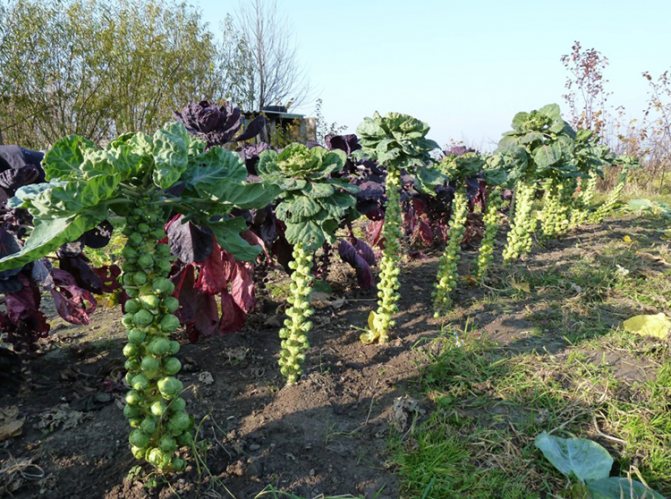

Before planting corn, you need to have an idea about the description of this crop and its varieties.
Corn is a robust annual plant with a well-developed root system. It has an erect thick stem up to 2 m high. The leaves are large, 60-80 cm long, glabrous on the lower side, pubescent on the upper side. Each stem develops from 1 to 3, and taking into account the stepsons and up to 4-6 ears. On the cob, depending on the variety and conditions, there may be 400-800 grains of a round, wedge-shaped, elongated or elongated shape, located in 8-16 rows.
Yellow and white grain color predominates, but there are forms with orange, pink, red and black color. All yellow-grain varieties contain more vitamins than white-grain varieties. The ripening of the ears occurs from top to bottom, that is, the top ear ripens first.
According to the type of grain, its biological composition, corn is subdivided into 8 subspecies or groups: siliceous, dentate, starchy, sugar, bursting, waxy, starchy-sugar and membranous.
The best varieties of corn: early ripe ones - Aurika, Lakomka Belogorya, Early gourmet 121, Saratov sugar, Spirit, Morning song; mid-season-Boston, Sovereign.
If you like corn in a milky-wax ripeness, the sugar subspecies (Zea mays convar.saccharata) is most suitable. It has a translucent, wrinkled grain. During the period of milk ripeness, the sugar content in the grain reaches 15-18%; protein - about 13%, fat 8%.
Botanically, it is an annual plant. The stem is straight, non-lying, branching at the base, up to 180 cm high. Leaves are compound, end with a tip instead of a tendril. The root system is pivotal, with powerful lateral branches, penetrates the soil to a depth of 1.5 m or more. The flowers are large, white with black velvet spots on the wings, fragrant.
Flowering begins. 20-35 days after the emergence of seedlings, the technical ripeness of the first beans occurs in 35-65 days; the duration of the growing season is 95-130 days. In technical ripeness, immature fruits are soft, tender, in biological ripeness, their valves harden, coarse, acquire a black or brown color.
The best varieties of beans: Belorusskie, Velena, Virovskie and Russian black.
The description of this culture is worth ending with the fact that beans are an excellent predecessor for almost all crops. Tuber bacteria settle on the roots of beans, like other legumes, fixing nitrogen from the air. After they die off, the soil receives 15-20 g of this valuable nutrient per 1 m2 of sowing.
In addition, the root system of beans has an increased ability to assimilate sparingly soluble phosphorus compounds that are inaccessible to other crops, and, after composting plant residues, return these compounds to the soil in an easily assimilable form. With a long taproot, the plant penetrates the soil and, dying in the fall, leaves natural channels in the meter layer through which air enters the soil, which contributes to the activation of microbiological processes.
If you do not know which variety of Brussels sprouts to choose, focus primarily on the climate of your region and such an indicator as the ripening period. If your summer is short, choose early ripening varieties, but if there is enough time before the cold weather, you can experiment with mid- and late-ripening varieties.
Early maturing varieties of Brussels sprouts (ripening period up to 130 days): Pomegranate bracelet, Dolmik, Isabella, Casio, Commander, Rosella, Rudnef, Franklin.
Mid-season varieties of Brussels sprouts (ripening period from 130 to 150 days): Brilliant, Boxer, Veselaya Kompaniya, Pomegranate, Hercules, Dauer Riesen, Perfection.
Late-ripening varieties of Brussels sprouts (ripening period from 150 to 180 days): Gruniger, Curl.
Now that you know everything about growing Brussels sprouts, all that remains is to buy seeds and be patient. Perhaps this season you will have a new favorite among vegetables.
Seedlings with a stem thickness of ~ 5 mm with a minimum of 5 leaves up to 20 cm high are ready for transplanting into open ground. Usually - this is the last decade of May - mid-June.
The right place for growing cabbage is the key to an excellent harvest. It depends on what crops germinated last season in this garden. If the predecessors were grains, legumes, potatoes, carrots, or onions, great. And it is advisable to refuse from the beds where beets, tomatoes, radishes grew.
Brussels sprouts grow well in sunny southern or southeastern areas. Loves loamy fertile soil. Its preparation begins in the fall with a deep (to the depth of a shovel) digging. Lime is added if necessary. In the spring, the soil is fertilized with organic matter per 1 sq. m - 1 bucket, loosened to a depth of 5 cm. Additionally, when planting seedlings, add to each hole: 2 glasses of wood ash, 2 tbsp. tablespoons of superphosphate, 1 tsp. urea.
In the prepared soil, seedlings are planted in holes arranged according to the scheme - 60x60 cm. The size of the dug hole should be larger than the size of the root system of the seedling together with the lump. Fertilizers are spread into it, lightly mixed with the ground, then the seedling sprout is transferred from the seedling container to the prepared hole by transferring it. Watering with warm water falls asleep slightly compacted.
How to store?
For winter storage, late-ripening varieties of Brussels sprouts are grown, therefore:
- plants are removed from the site last;
- the stem is cut off at the very root or dug out with it;
- cut plants are dropped into boxes with sand, and the rest - with the roots in a container with moist soil;
- maintain a temperature of 3-5 ° C;
- the soil is occasionally watered.
Stems with heads of cabbage, but without foliage, can be stored in the basement and suspended. Separately, the fruits are not stored for long, but they can be frozen and dried.
Every gardener who values his own and those close to him health is simply obliged to plant this wonderful plant on the site. Thanks to the vegetable protein, Brussels sprouts will protect the nervous system from stress, and the vitamin C contained in it, which is more than in oranges and lemons, will strengthen the immune system and give new strength to work in the garden.
Breeding conditions
How to grow this variety outdoors in the garden, when and how to plant it for seedlings? Seedlings need to provide a temperature of about 5-6 ° C at night, during the day - 16-18 ° C and normal illumination. At the same time, the air humidity should be at least 70%.
Brussels sprouts emerge very quickly - in 4-6 days.Sow seeds at a distance of three to four centimeters from each other and to a depth of two centimeters.
It is only necessary to grow cabbage in a well-lit place, since the plant does not tolerate shade well.


